April 27: Venus brightest in morning sky for all of 2025 this weekend
Venus is the brightest planet, and it’s now brightest in the morning sky for all of 2025. You can’t miss it in the east before dawn. If you looked at Venus through a telescope now, you’d see a waxing crescent world. How can a crescent Venus appear brighter than the full Venus we see at other times? EarthSky’s Deborah Byrd brings you the story. Watch in the player above or on YouTube.
Read more: Venus brightest in the morning sky on April 27, 2025
See more “smiley face moon” photos from the EarthSky community
Late April morning planets: Venus, Saturn, Mercury
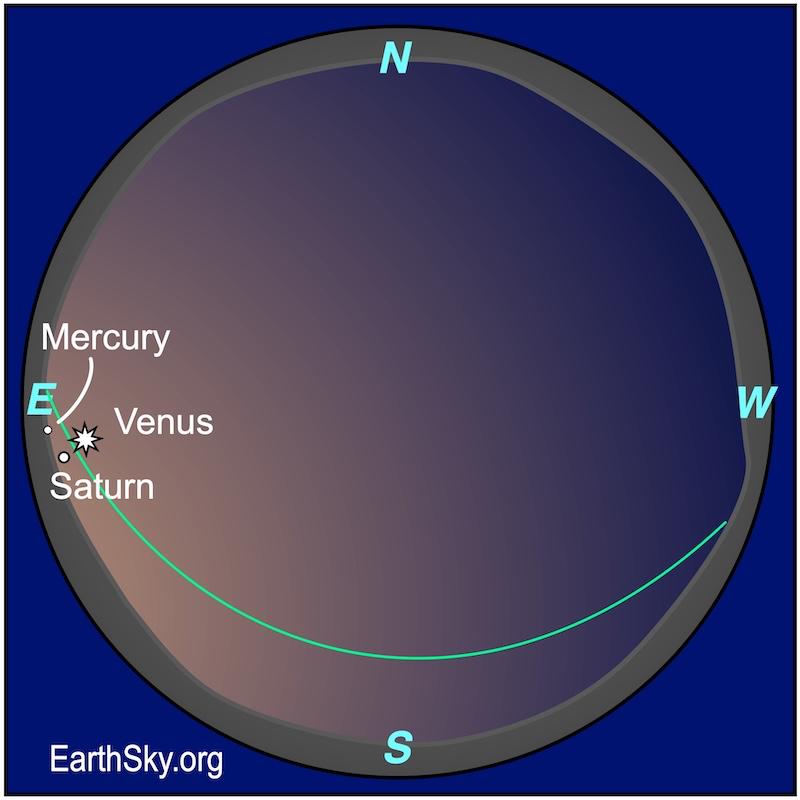 There are 3 planets in the morning sky in late April 2025. They will lie along the path the sun travels in daytime (the green line on our chart). Look for them about 30-40 minutes before sunrise. Bright Venus will be the easiest to spot and rises early enough that you MIGHT catch it before dawn. Mercury is brighter than most stars, but it is hard to see in the bright morning twilight. Saturn is the dimmest of the 3 planets and might be challenging to spot. Venus and Saturn will be easier to spot next month. Mercury will slip away from the morning sky later this month. Chart via EarthSky.
There are 3 planets in the morning sky in late April 2025. They will lie along the path the sun travels in daytime (the green line on our chart). Look for them about 30-40 minutes before sunrise. Bright Venus will be the easiest to spot and rises early enough that you MIGHT catch it before dawn. Mercury is brighter than most stars, but it is hard to see in the bright morning twilight. Saturn is the dimmest of the 3 planets and might be challenging to spot. Venus and Saturn will be easier to spot next month. Mercury will slip away from the morning sky later this month. Chart via EarthSky.
Our charts are mostly set for the northern half of Earth. To see a precise view – and time – from your location, try Stellarium Online.
Late April evening planets: Jupiter and Mars
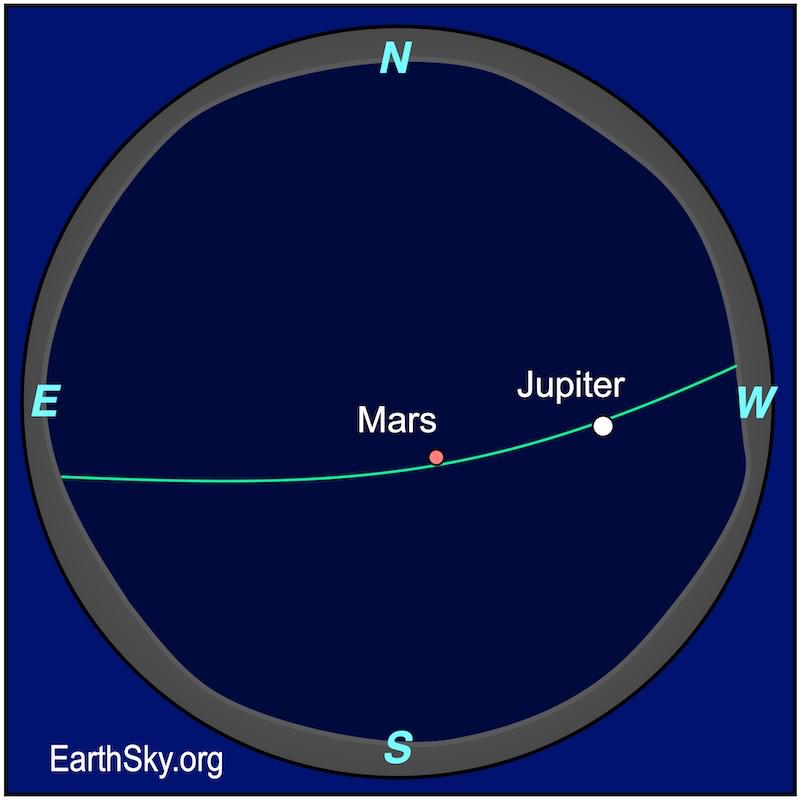 You can see 2 planets in the evening sky in April 2025. They will lie along the path the sun travels in daytime (the green line on our chart). As darkness falls, look for bright Jupiter high in the western sky and reddish Mars almost overhead. Jupiter will set before midnight by month’s end and Mars will set a few hours later. Chart via EarthSky.
You can see 2 planets in the evening sky in April 2025. They will lie along the path the sun travels in daytime (the green line on our chart). As darkness falls, look for bright Jupiter high in the western sky and reddish Mars almost overhead. Jupiter will set before midnight by month’s end and Mars will set a few hours later. Chart via EarthSky.
April 27: New moon
The moment of new moon will fall at 19:31 UTC (2:31 p.m. CDT) on April 27, 2025. New moons rise and set with the sun. It’s the 3rd of 5 new supermoons in a row for 2025. And it’s the closest new moon of the year. Nights around the new moon are perfect for stargazing. See EarthSky’s best places to stargaze.
Read more: What is a supermoon? Supermoons in 2025
See the moon go through different phases – from new to full – in this EarthSky community photo.
April 27: Moon reaches perigee
The moon will reach perigee – its closest point to us in its elliptical orbit around Earth – at 16 UTC (11 a.m. CDT) on April 27, 2025, when it’s 221,902 miles (357,118 km) away. Large tides possible.
April moon phases and alignments
Join EarthSky’s Marcy Curran in a video preview of the moon phases for the month of April 2025. The moon will visit Venus, Jupiter and Mars in the morning and evening sky. And we’ve got the most distant full moon of the year. Plus there’s a lot more to see this month. Watch the video here or on YouTube.
April 28 and 29 evenings: Slender moon and Jupiter
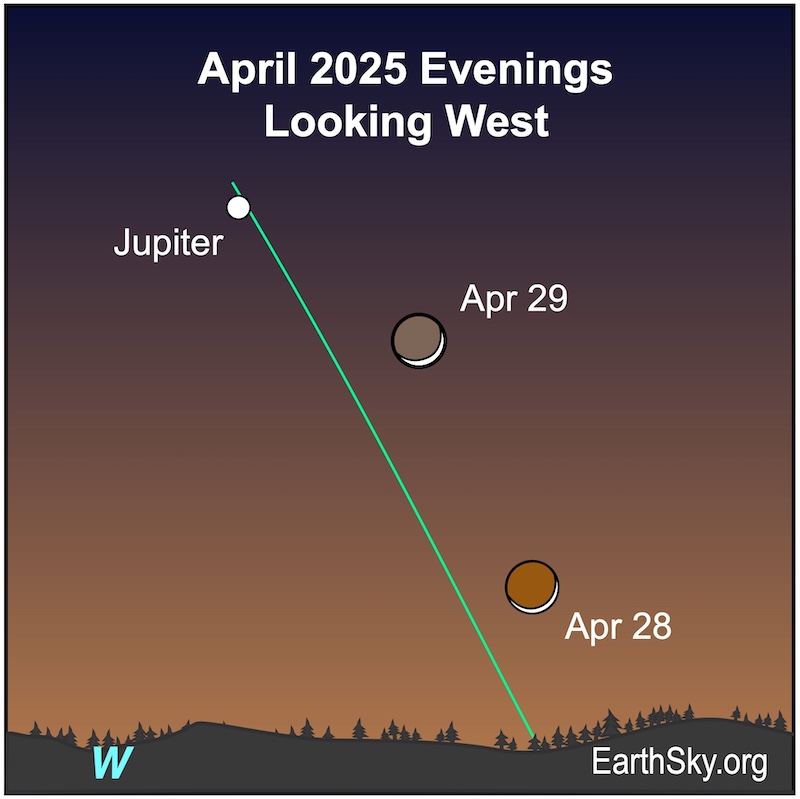 About 60 minutes after sunset on April 28, 2025, the thin waxing crescent moon will lie low above the western horizon with Jupiter nearby. On the following evening, April 29, a thicker crescent moon will hang near Jupiter. They’ll set a few hours after sunset. Look for lovely a glow of earthshine on the unlit portion of the moon. That’s light reflected off Earth. Chart via EarthSky.
About 60 minutes after sunset on April 28, 2025, the thin waxing crescent moon will lie low above the western horizon with Jupiter nearby. On the following evening, April 29, a thicker crescent moon will hang near Jupiter. They’ll set a few hours after sunset. Look for lovely a glow of earthshine on the unlit portion of the moon. That’s light reflected off Earth. Chart via EarthSky.
Read more: Earthshine is a lovely glow on the unlit portion of the moon
April 30 evening: Moon and Jupiter
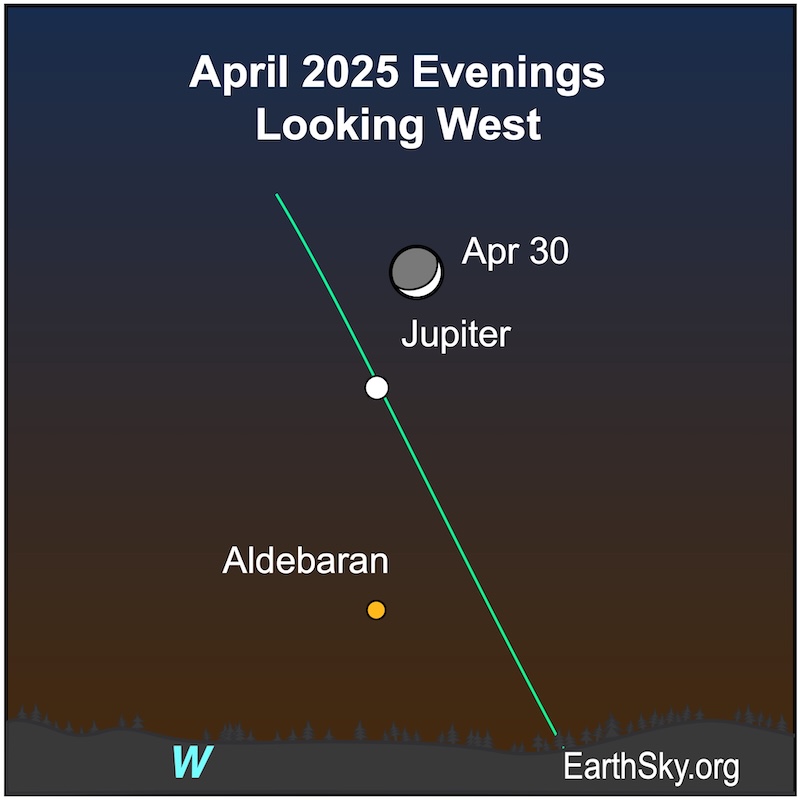 About 90 minutes after sunset on April 30, 2025, the waxing crescent moon will lie close to bright Jupiter in the western sky. Nearby is the fiery eye of Taurus the Bull, Aldebaran. They’ll set around midnight. Chart via EarthSky.
About 90 minutes after sunset on April 30, 2025, the waxing crescent moon will lie close to bright Jupiter in the western sky. Nearby is the fiery eye of Taurus the Bull, Aldebaran. They’ll set around midnight. Chart via EarthSky.
Our charts are mostly set for the northern half of Earth. To see a precise view – and time – from your location, try Stellarium Online.
May 1 and 2 evenings: Moon near Jupiter and pairs up with the twin stars
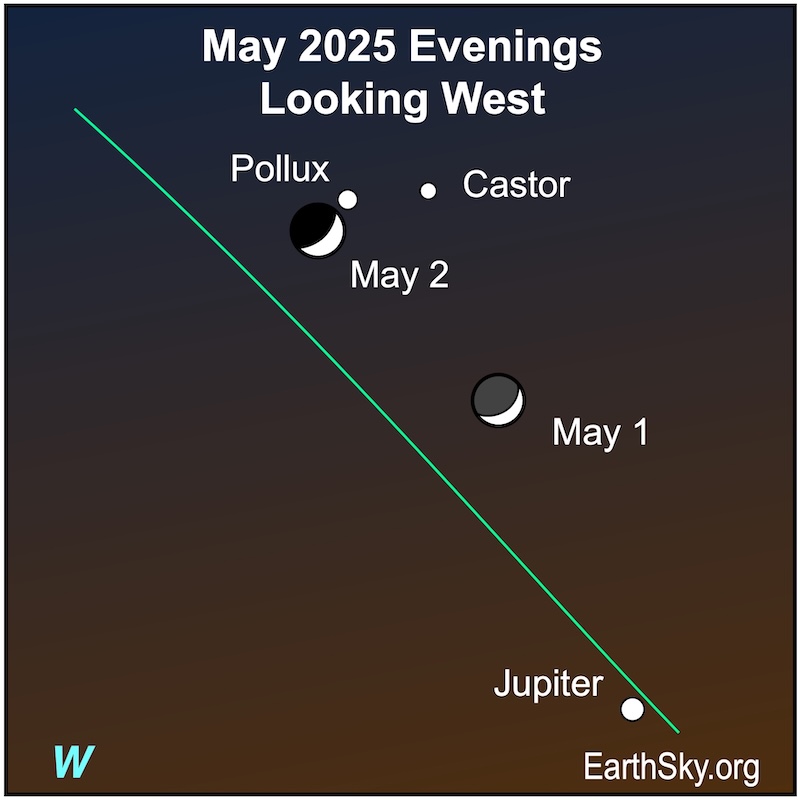 An hour after sunset on the evenings of May 1 and 2, 2025, the waxing crescent moon will lie near Jupiter with the twin stars of Gemini, Castor and Pollux, nearby. Chart via EarthSky.
An hour after sunset on the evenings of May 1 and 2, 2025, the waxing crescent moon will lie near Jupiter with the twin stars of Gemini, Castor and Pollux, nearby. Chart via EarthSky.
May 3 evening: The Moon and Mars buzz the Beehive
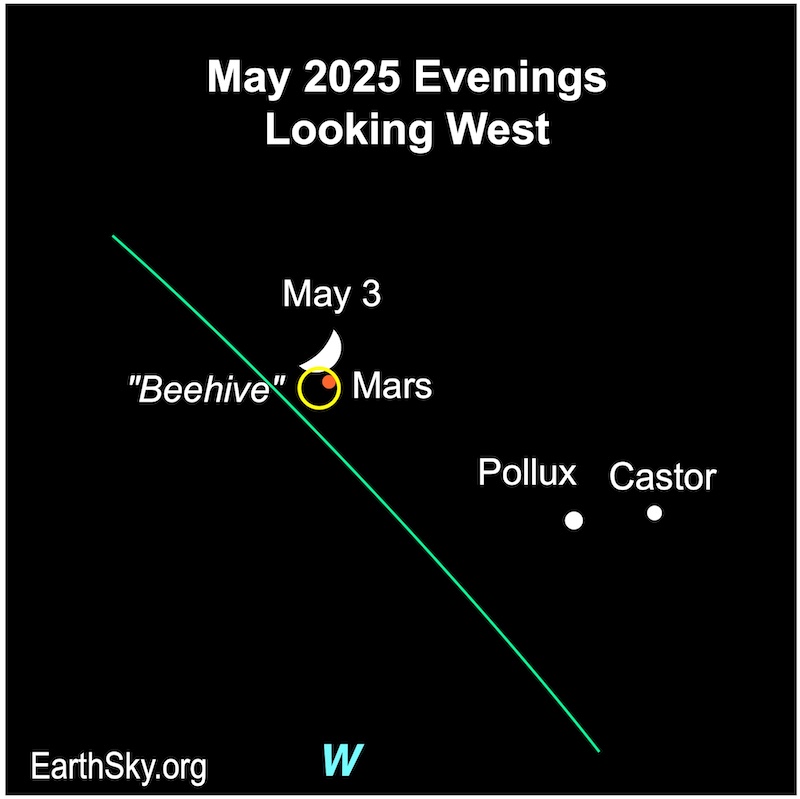 On the evening of May 3, 2025, the thick waxing crescent moon will glow close to Mars and the Beehive star cluster. The twin stars of Gemini, Castor and Pollux, are nearby. They’ll set after midnight. Mars will lie closest to the Beehive cluster at 0 UTC on May 5. Chart via EarthSky.
On the evening of May 3, 2025, the thick waxing crescent moon will glow close to Mars and the Beehive star cluster. The twin stars of Gemini, Castor and Pollux, are nearby. They’ll set after midnight. Mars will lie closest to the Beehive cluster at 0 UTC on May 5. Chart via EarthSky.
Read more: Meet Gemini the Twins, home to 2 bright stars
May 3 evening: Moon, Mars and the Beehive binocular view
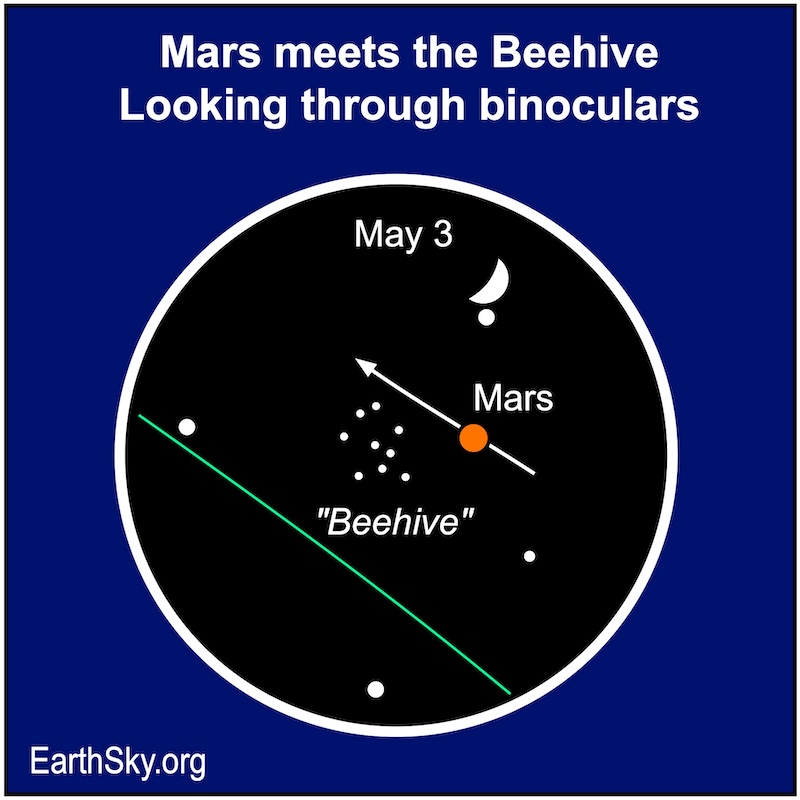 Binocular view of the crescent moon near Mars and the Beehive on the evening of May 3.
Binocular view of the crescent moon near Mars and the Beehive on the evening of May 3.
May 4: 1st quarter moon
The moment of 1st quarter moon will fall at 13:52 UTC on May 4, 2025. That’s 8:52 a.m. CDT. A 1st quarter moon rises around noon your local time and sets around midnight. Watch for a 1st quarter moon high in the sky at sundown.
Want more? Here are 4 keys to understanding the moon’s phases.
May 4 and 5 evenings: Moon, Regulus and the Sickle
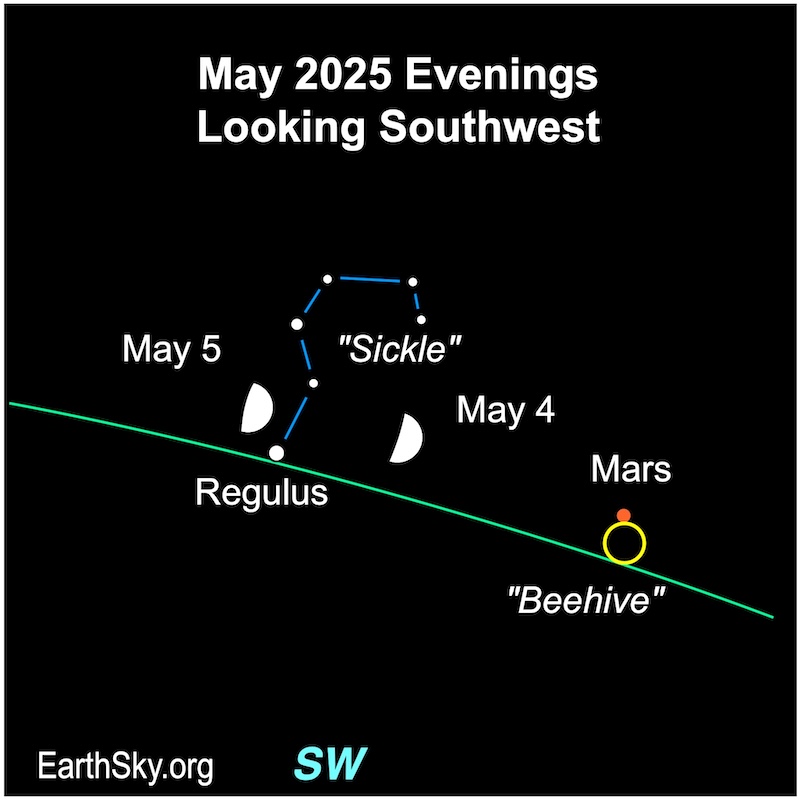 In the early evening hours of May 4, 2025, the 1st quarter moon will lie between Mars and the Sickle of Leo the Lion. Then on May 5, the waxing gibbous moon will glow near Regulus, the brightest star in Leo. They’ll set a few hours after midnight. Chart via EarthSky.
In the early evening hours of May 4, 2025, the 1st quarter moon will lie between Mars and the Sickle of Leo the Lion. Then on May 5, the waxing gibbous moon will glow near Regulus, the brightest star in Leo. They’ll set a few hours after midnight. Chart via EarthSky.
Read more: Leo the Lion and its backward question mark
Our charts are mostly set for the northern half of Earth. To see a precise view – and time – from your location, try Stellarium Online.
Mornings of May 5 and 6: Eta Aquariid meteor shower
The predicted peak of the Eta Aquariid meteor shower is 15 UTC on May 5. And the Eta Aquariid meteors you see are remnants of Halley’s Comet! The peak of this shower stretches out over several days. So you can expect elevated numbers of meteors a few days before and after the peak time. The mornings of both May 5 and May 6 are good times to watch!
Read more: 2025 Eta Aquariid meteor shower: All you need to know
A pair of planets in the evening sky
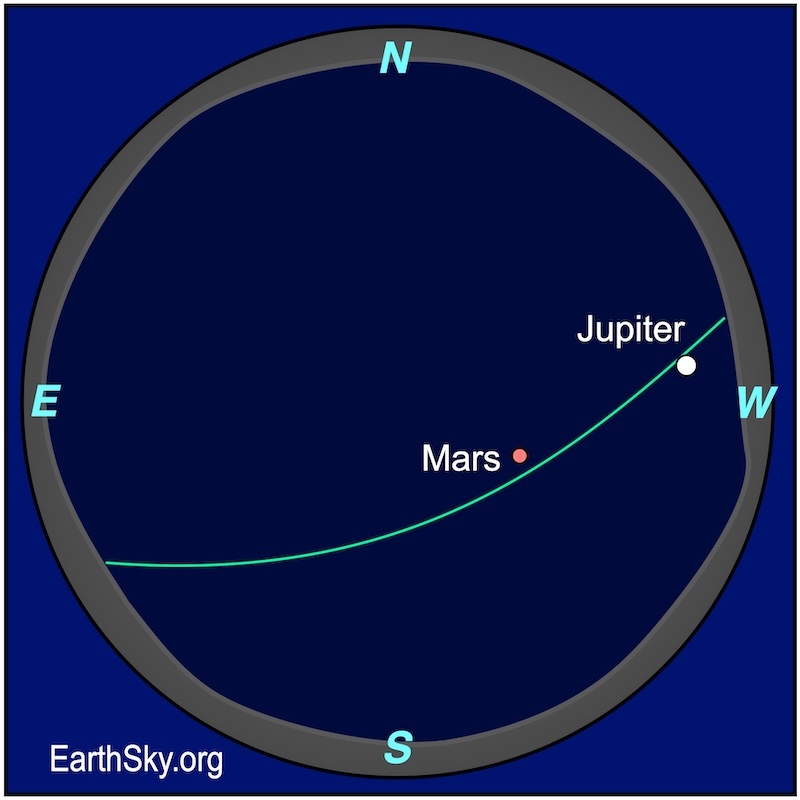 You can see 2 planets in the evening sky in May 2025. They will lie along the path the sun travels in the daytime (the green line on our chart). As darkness falls, look for bright Jupiter high in the western sky and reddish Mars almost overhead. Jupiter will set before midnight at the beginning of the month, and by month’s end it’ll set after sunset, making it more difficult to spot in the bright evening twilight. And Mars will set a few hours later. Chart via EarthSky.
You can see 2 planets in the evening sky in May 2025. They will lie along the path the sun travels in the daytime (the green line on our chart). As darkness falls, look for bright Jupiter high in the western sky and reddish Mars almost overhead. Jupiter will set before midnight at the beginning of the month, and by month’s end it’ll set after sunset, making it more difficult to spot in the bright evening twilight. And Mars will set a few hours later. Chart via EarthSky.
A trio of planets in the morning sky: Northern Hemisphere
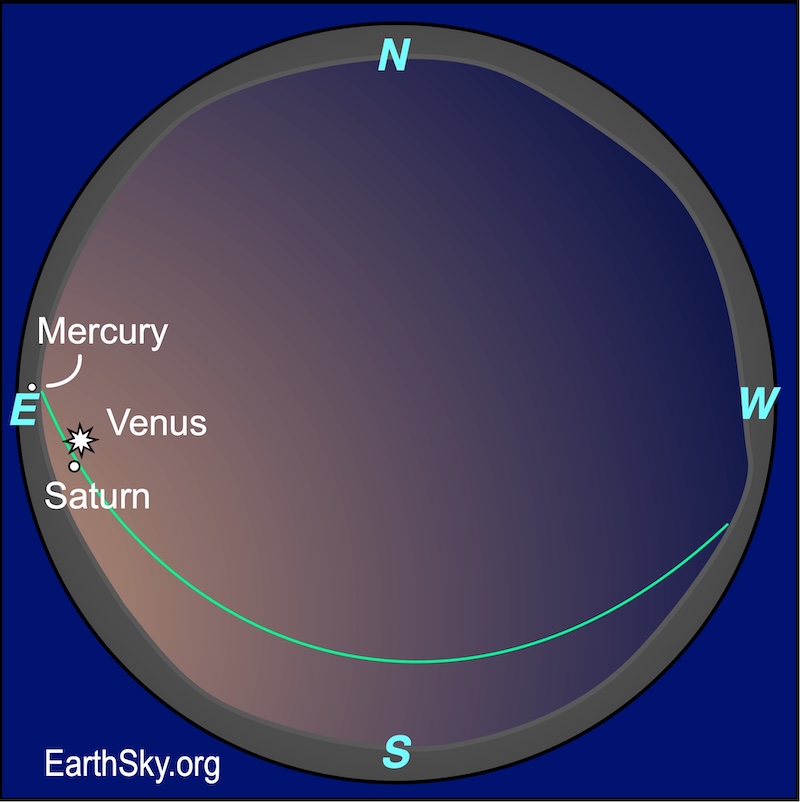 There are 3 planets in the morning sky in early May 2025. They will lie along the path the sun travels in the daytime (the green line on our chart). Look for them about 30-40 minutes before sunrise. Bright Venus will be the easiest to spot. Mercury is brighter than most stars, but it’s hard to see in the bright morning twilight and it’s low on the horizon. Viewers in the Southern Hemisphere have a better chance of spotting it, because this is their best apparition of Mercury in the morning sky this year. Saturn is the dimmest of the 3 planets and might be challenging to spot. Venus will reach its greatest distance from the morning sun on May 31-June 1. It’ll remain visible in the morning sky through October. Mercury will slip away from the morning sky around mid-month. It’ll emerge in the evening sky in June and reach its greatest distance from the evening sun on July 4. Keep an eye on Venus and Saturn this month, they drift farther apart each day. Chart via EarthSky.
There are 3 planets in the morning sky in early May 2025. They will lie along the path the sun travels in the daytime (the green line on our chart). Look for them about 30-40 minutes before sunrise. Bright Venus will be the easiest to spot. Mercury is brighter than most stars, but it’s hard to see in the bright morning twilight and it’s low on the horizon. Viewers in the Southern Hemisphere have a better chance of spotting it, because this is their best apparition of Mercury in the morning sky this year. Saturn is the dimmest of the 3 planets and might be challenging to spot. Venus will reach its greatest distance from the morning sun on May 31-June 1. It’ll remain visible in the morning sky through October. Mercury will slip away from the morning sky around mid-month. It’ll emerge in the evening sky in June and reach its greatest distance from the evening sun on July 4. Keep an eye on Venus and Saturn this month, they drift farther apart each day. Chart via EarthSky.
May morning planets: Southern Hemisphere
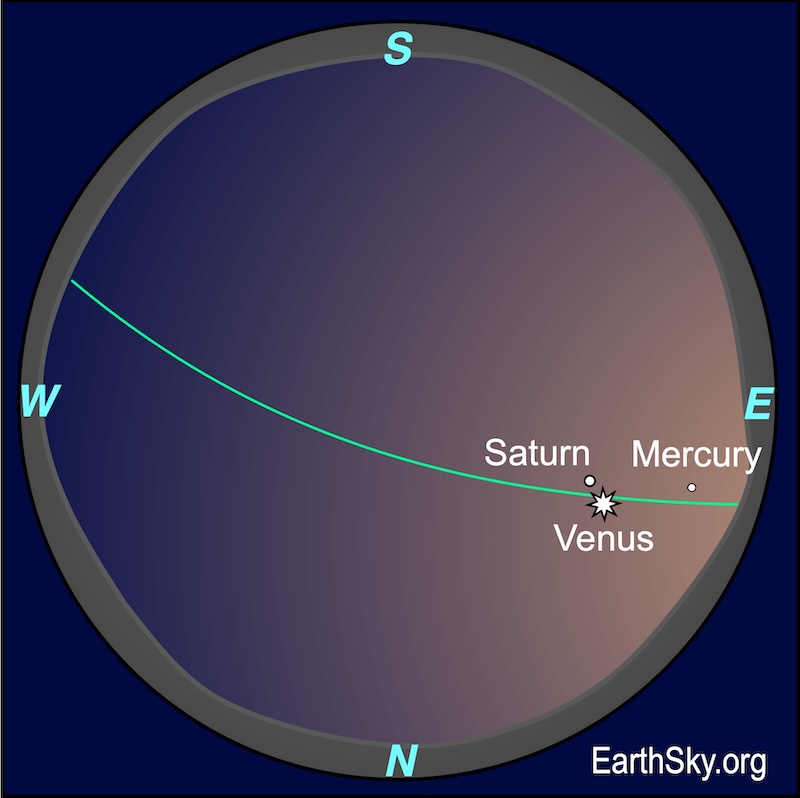 For the Southern Hemisphere, the 3 planets in the morning sky in early May 2025 will be easier to see. They will lie along the path the sun travels in the daytime (the green line on our chart). Look for them about 40 minutes before sunrise. Bright Venus will be the easiest to spot and will rise first. Mercury is brighter than most stars, but it’s low on the horizon. Viewers in the Southern Hemisphere have a better chance of spotting it since this is their best apparition of Mercury in the morning sky this year. Saturn is the dimmest of the 3 planets and might be a challenge. Mercury will slip away from the morning sky later in the month. Venus will reach its greatest distance from the morning sun on May 31-June 1. It’ll remain visible in the morning sky through October. Mercury will emerge in the evening sky in June and it’ll reach its greatest distance from the evening sun on July 4. Keep an eye on Venus and Saturn, they’ll move apart all month. Chart via EarthSky.
For the Southern Hemisphere, the 3 planets in the morning sky in early May 2025 will be easier to see. They will lie along the path the sun travels in the daytime (the green line on our chart). Look for them about 40 minutes before sunrise. Bright Venus will be the easiest to spot and will rise first. Mercury is brighter than most stars, but it’s low on the horizon. Viewers in the Southern Hemisphere have a better chance of spotting it since this is their best apparition of Mercury in the morning sky this year. Saturn is the dimmest of the 3 planets and might be a challenge. Mercury will slip away from the morning sky later in the month. Venus will reach its greatest distance from the morning sun on May 31-June 1. It’ll remain visible in the morning sky through October. Mercury will emerge in the evening sky in June and it’ll reach its greatest distance from the evening sun on July 4. Keep an eye on Venus and Saturn, they’ll move apart all month. Chart via EarthSky.
May 9 and 10 evenings: Moon pairs up with Spica
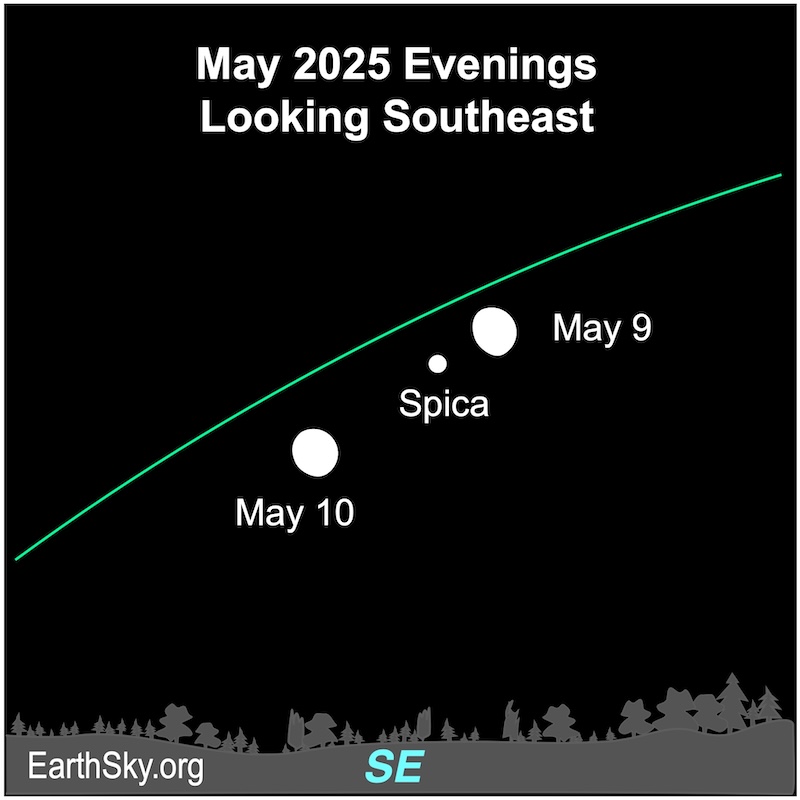 In the early evening hours of May 9 and 10, 2025, the bright waxing gibbous moon will visit Spica, the brightest star in Virgo the Maiden. Spica might be difficult to see in the moon’s bright glow. They’ll set before dawn. What’s more, a few lucky observers will see the moon occult – or pass in front of – Spica. If you look outside then and don’t see Spica … that might be because it’s behind the moon! Details on the occultation here. They’ll set before dawn the next morning. Chart via EarthSky.
In the early evening hours of May 9 and 10, 2025, the bright waxing gibbous moon will visit Spica, the brightest star in Virgo the Maiden. Spica might be difficult to see in the moon’s bright glow. They’ll set before dawn. What’s more, a few lucky observers will see the moon occult – or pass in front of – Spica. If you look outside then and don’t see Spica … that might be because it’s behind the moon! Details on the occultation here. They’ll set before dawn the next morning. Chart via EarthSky.
Read more: Virgo the Maiden represents a harvest goddess
Our charts are mostly set for the northern half of Earth. To see a precise view – and time – from your location, try Stellarium Online.
May 11: Moon reaches apogee
The moon will reach apogee – its farthest distance from Earth in its elliptical orbit – at 1 UTC on May 11, 2025, when it’s 252,427 miles (406,243 km) away.
May 12-13 overnight: Full Flower Moon
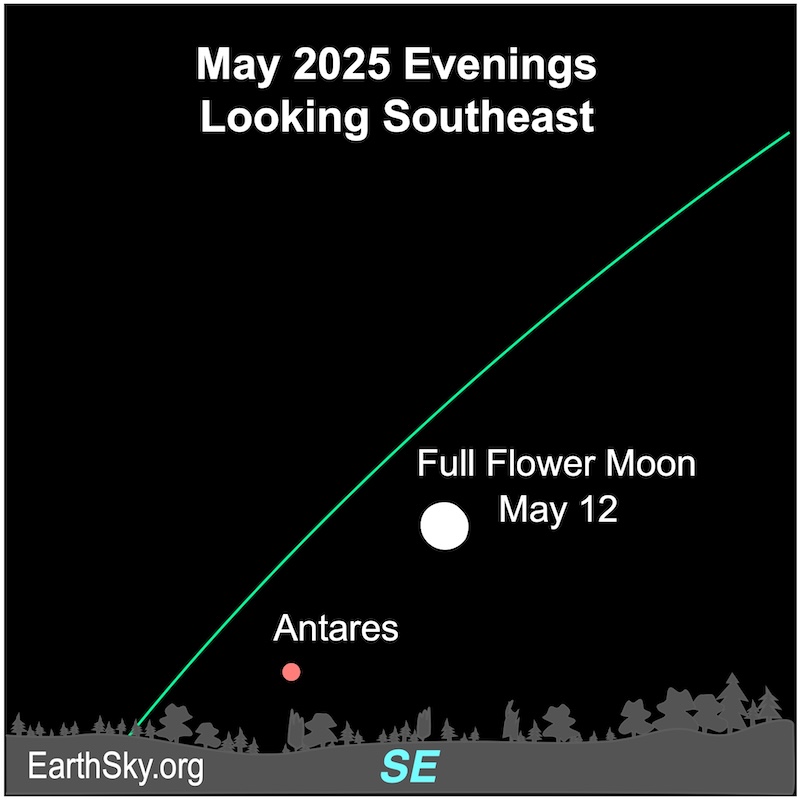 Soon after the sunset on May 12, 2025, the bright May full Flower Moon will lie near red Antares, the brightest star in Scorpius the Scorpion. The crest of the full moon occurs at 16:56 UTC (11:56 a.m. CDT) on April 12. They’ll be visible all night. It’s the 3rd of 3 full micromoons in a row for 2025. It’ll be 251,828 miles (405,278 kilometers) away. Chart via EarthSky.
Soon after the sunset on May 12, 2025, the bright May full Flower Moon will lie near red Antares, the brightest star in Scorpius the Scorpion. The crest of the full moon occurs at 16:56 UTC (11:56 a.m. CDT) on April 12. They’ll be visible all night. It’s the 3rd of 3 full micromoons in a row for 2025. It’ll be 251,828 miles (405,278 kilometers) away. Chart via EarthSky.
May 13 evening: Moon cozies up to Antares
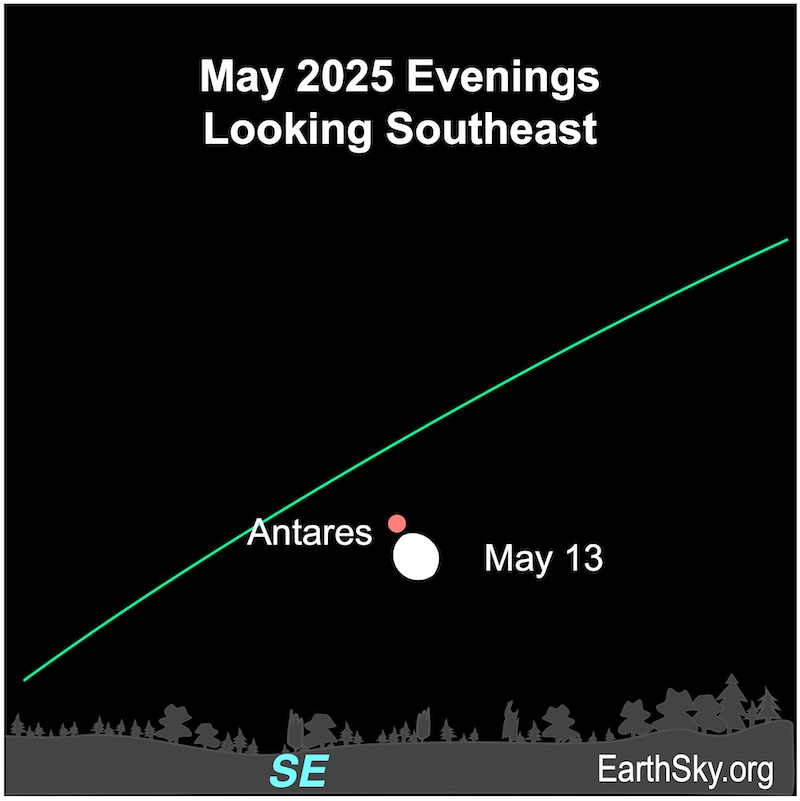 In the late evening hours of May 13, 2025, the waning gibbous moon will hang close to Antares, the brightest star in Scorpius the Scorpion. The star might be difficult to see in the moon’s bright glow. They’ll be crossing the sky all night and visible through dawn. What’s more, a few lucky observers will see the moon occult – or pass in front of – Antares. If you look outside then and don’t see Antares … that might be because it’s behind the moon! Details on the occultation here. Chart via EarthSky.
In the late evening hours of May 13, 2025, the waning gibbous moon will hang close to Antares, the brightest star in Scorpius the Scorpion. The star might be difficult to see in the moon’s bright glow. They’ll be crossing the sky all night and visible through dawn. What’s more, a few lucky observers will see the moon occult – or pass in front of – Antares. If you look outside then and don’t see Antares … that might be because it’s behind the moon! Details on the occultation here. Chart via EarthSky.
Read more: Massive ruby red Antares is the Scorpion’s Heart
May 15 and 16 mornings: Moon visits the Teapot
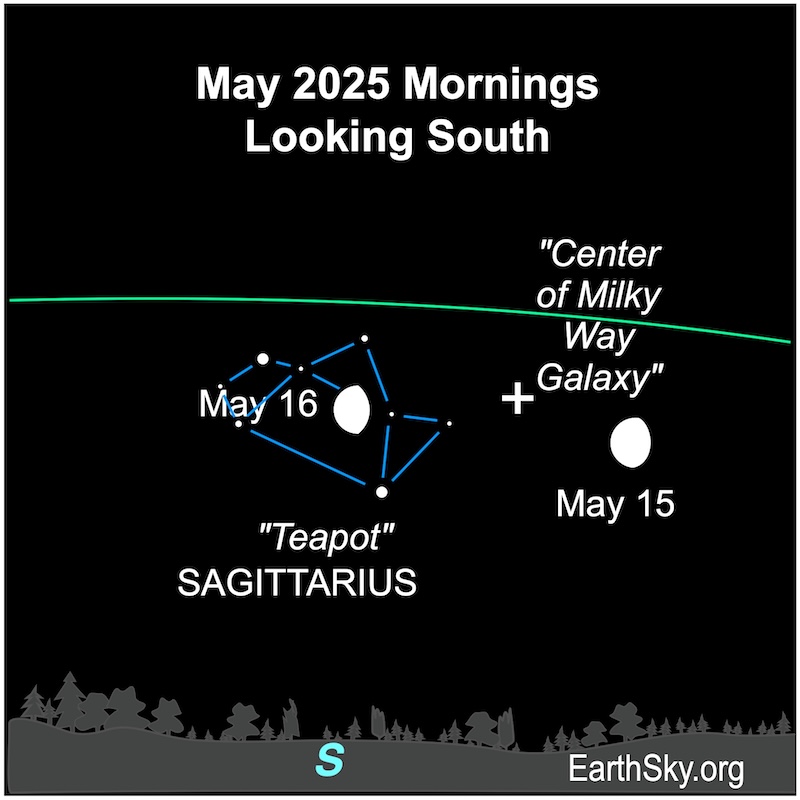 In the early morning hours of May 15, 2025, the waning gibbous moon will be near the Teapot asterism of Sagittarius the Archer. It will also be near the direction of the center of the Milky Way galaxy. On the following morning, May 16, it’ll float among the stars of the Teapot. Chart via EarthSky.
In the early morning hours of May 15, 2025, the waning gibbous moon will be near the Teapot asterism of Sagittarius the Archer. It will also be near the direction of the center of the Milky Way galaxy. On the following morning, May 16, it’ll float among the stars of the Teapot. Chart via EarthSky.
Read more: Teapot of Sagittarius points to Milky Way Center
May 20: Watch for the last quarter moon
The moment of last quarter moon will fall at 11:59 UTC on May 20, 2025. That’s 6:59 a.m. CDT. It’ll rise after midnight your local time and set around noon. Look for it high in the sky before dawn.
Want more? Here are 4 keys to understanding the moon’s phases.
May 22 to 24 mornings: Moon, Venus and Saturn
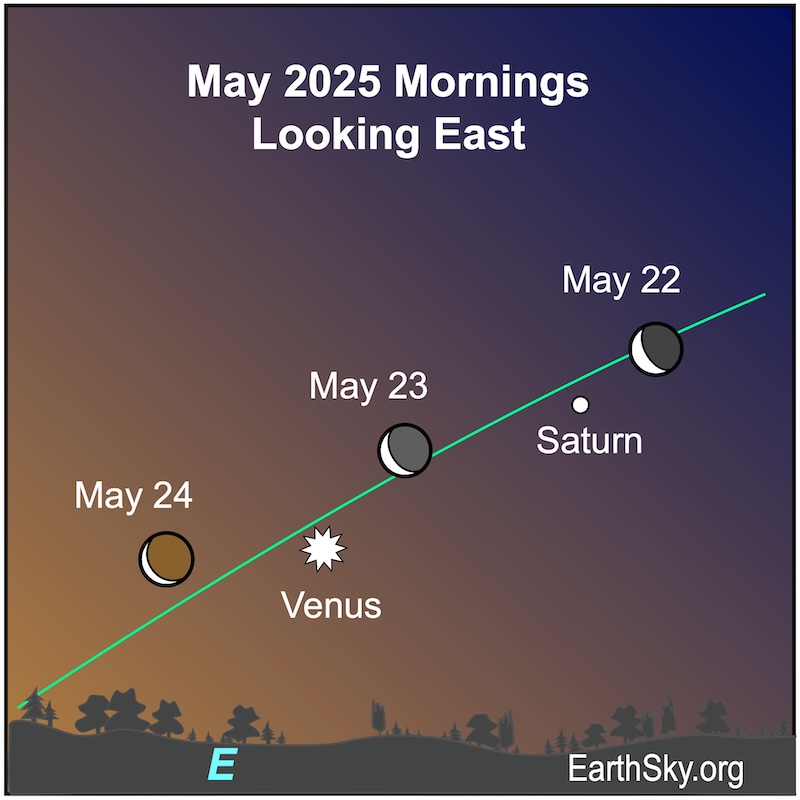 About 30 minutes before sunrise on May 22 to 24, 2025, the waning crescent moon will lie near – and pass by – bright Venus and Saturn. Chart via EarthSky.
About 30 minutes before sunrise on May 22 to 24, 2025, the waning crescent moon will lie near – and pass by – bright Venus and Saturn. Chart via EarthSky.
Our charts are mostly set for the northern half of Earth. To see a precise view – and time – from your location, try Stellarium Online.
May 25 morning: Moon and Venus
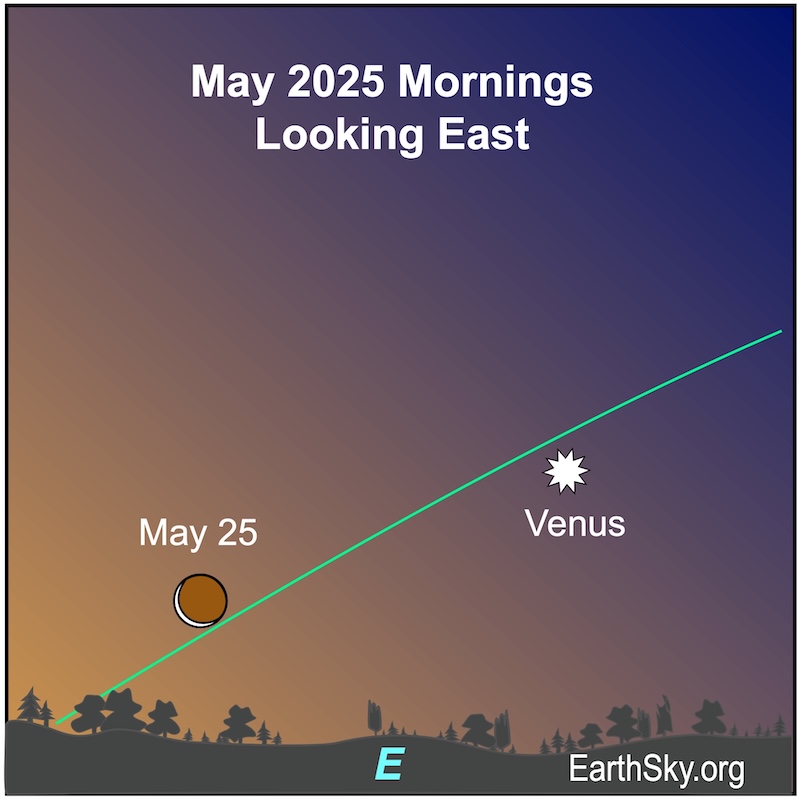 About 30 minutes before sunrise on May 25, 2025, the thin waning crescent moon will lie close to the horizon with bright Venus nearby. Chart via EarthSky.
About 30 minutes before sunrise on May 25, 2025, the thin waning crescent moon will lie close to the horizon with bright Venus nearby. Chart via EarthSky.
Read more: Venus will reach its greatest distance from the morning sun on May 31-June 1. It’ll remain visible in the morning sky through October.
May 26: Moon reaches perigee
The moon will reach perigee – its closest point to us in its elliptical orbit around Earth – at 2 UTC on May 26, 2025, when it’s 223,085 miles (359,022 km) away.
May 27: New moon
The moment of new moon will fall at 3:02 UTC on May 27, 2025. That’s 10:02 p.m. CDT on May 26. New moons rise and set with the sun. It’s the 4th of 5 new supermoons in a row for 2025. Nights around the new moon are perfect for stargazing. See EarthSky’s best places to stargaze.
See the moon phases from new to full in this EarthSky community photo.
Read more: What is a supermoon? Supermoons in 2025
May 27 and 28 evenings: Young moon challenge and Jupiter
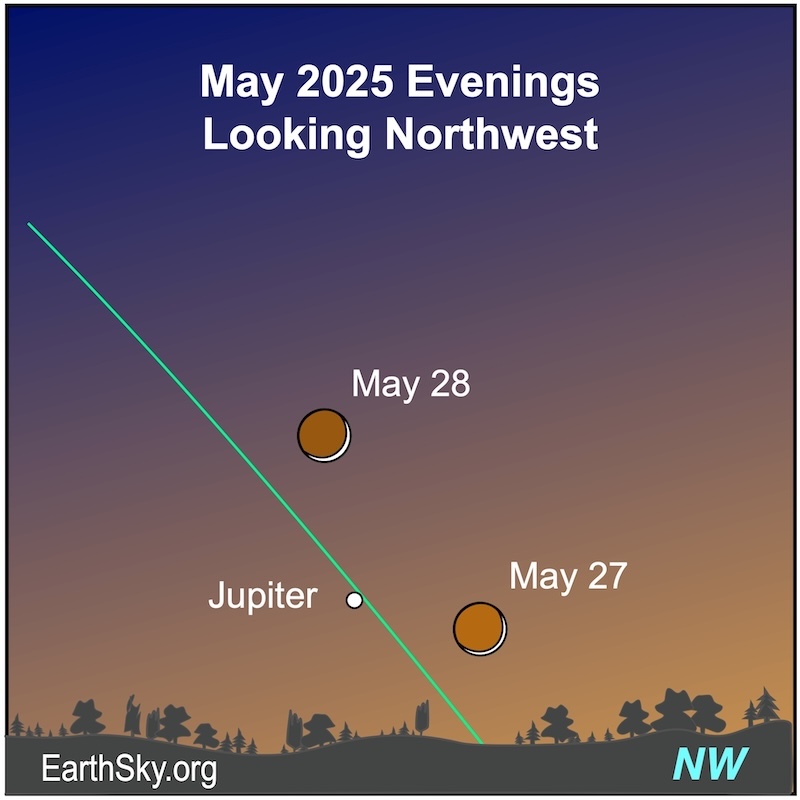 On May 27, look for a very young waxing crescent moon – in some places less than 24 hours old – about 30 to 40 minutes after sunset. It’ll be very thin and challenging to spot in the bright twilight. Binoculars might help spot it. Jupiter will be near the moon. Then look for a slightly thicker crescent moon the following evening. Also watch for the lovely glow of earthshine on the unlit portion of the moon. That’s light reflected off Earth. Chart via EarthSky.
On May 27, look for a very young waxing crescent moon – in some places less than 24 hours old – about 30 to 40 minutes after sunset. It’ll be very thin and challenging to spot in the bright twilight. Binoculars might help spot it. Jupiter will be near the moon. Then look for a slightly thicker crescent moon the following evening. Also watch for the lovely glow of earthshine on the unlit portion of the moon. That’s light reflected off Earth. Chart via EarthSky.
May 29: Moon and twin stars
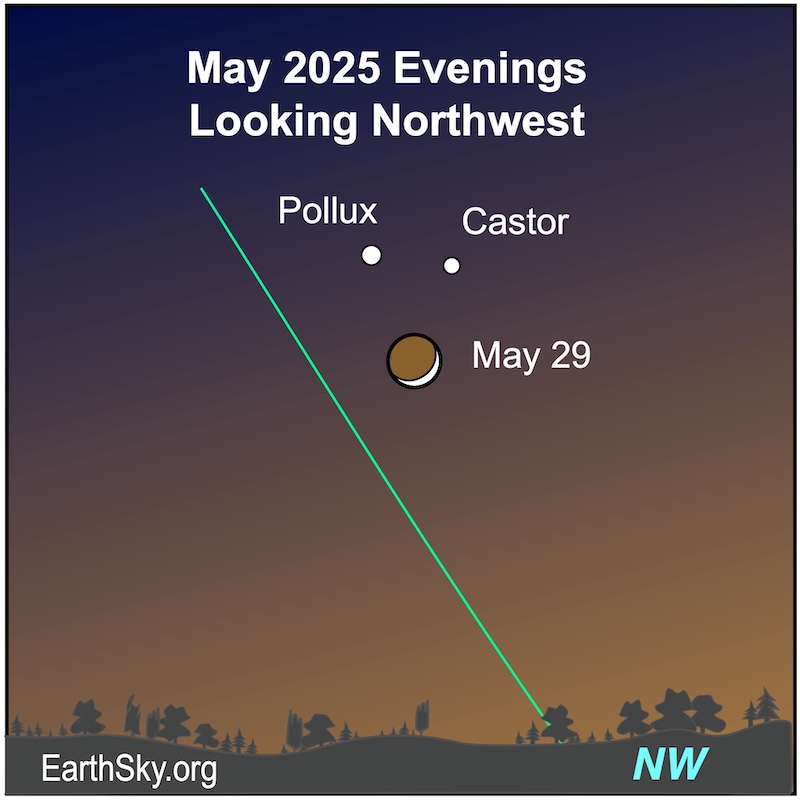 About 30 minutes after sunset on May 29, 2025, the waxing crescent moon will float near the twin stars of Gemini, Castor and Pollux. They’ll set a few hours after sunset. Chart via EarthSky.
About 30 minutes after sunset on May 29, 2025, the waxing crescent moon will float near the twin stars of Gemini, Castor and Pollux. They’ll set a few hours after sunset. Chart via EarthSky.
Our charts are mostly set for the northern half of Earth. To see a precise view – and time – from your location, try Stellarium Online.
May 30: Mercury in superior conjunction
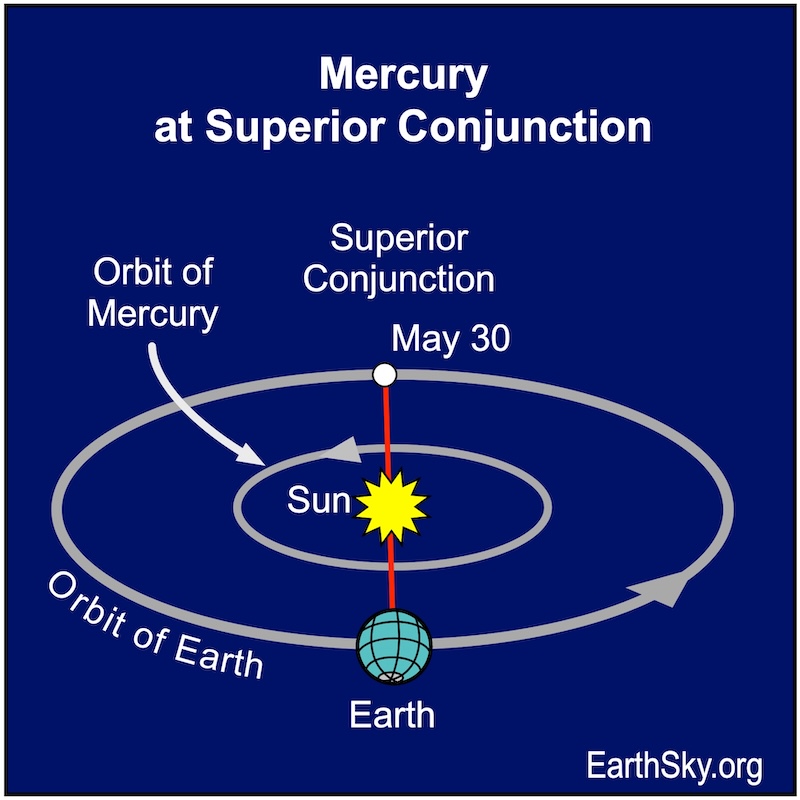 Mercury will lie on the far side of the sun on May 30, 2025, reaching the point in its orbit known as superior conjunction at 4 UTC. Since it is behind the sun, it can’t be seen from Earth. It’ll emerge in the evening sky in June. Chart via EarthSky.
Mercury will lie on the far side of the sun on May 30, 2025, reaching the point in its orbit known as superior conjunction at 4 UTC. Since it is behind the sun, it can’t be seen from Earth. It’ll emerge in the evening sky in June. Chart via EarthSky.
May 30 and 31: Moon, Mars and twin stars
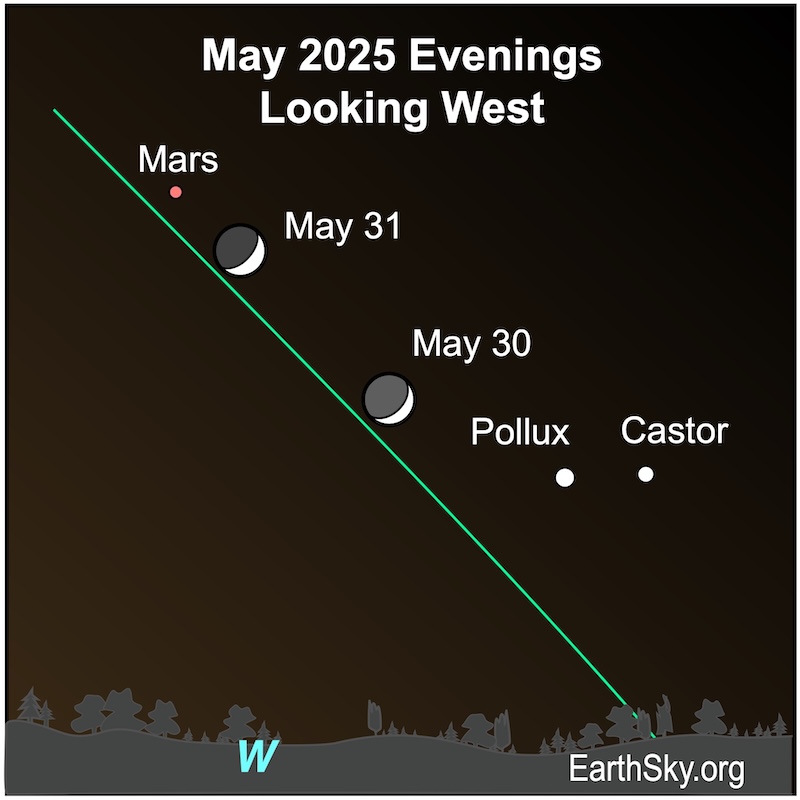 About 60 minutes after sunset on May 30 and 31, 2025, the waxing crescent moon will float between Mars and the twin stars of Gemini, Castor and Pollux. Chart via EarthSky.
About 60 minutes after sunset on May 30 and 31, 2025, the waxing crescent moon will float between Mars and the twin stars of Gemini, Castor and Pollux. Chart via EarthSky.
May 31-June 1: Venus greatest elongation from the sun
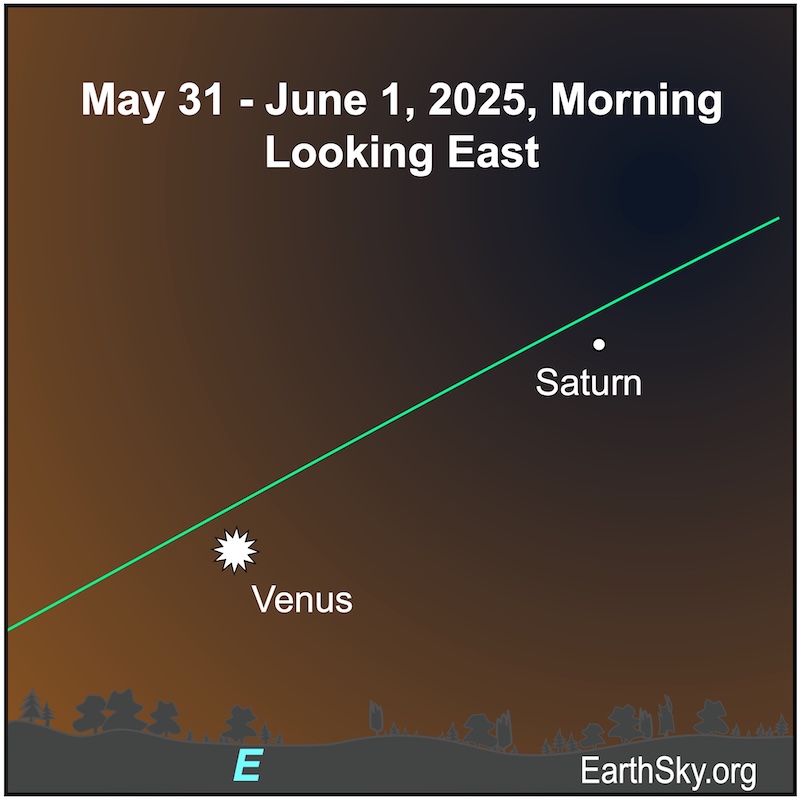 Venus will appear farthest from the sun in the morning sky on May 31 or June 1, depending on your location on the globe. On these mornings, Venus will be about 46 degrees, or 4 1/2 fist widths, from the sun. This position in its orbit is known as greatest western elongation. Each morning after this, Venus will move slightly closer to the sun. And the planet Saturn is nearby. Chart via EarthSky.
Venus will appear farthest from the sun in the morning sky on May 31 or June 1, depending on your location on the globe. On these mornings, Venus will be about 46 degrees, or 4 1/2 fist widths, from the sun. This position in its orbit is known as greatest western elongation. Each morning after this, Venus will move slightly closer to the sun. And the planet Saturn is nearby. Chart via EarthSky.
Read more: Venus greatest distance from the morning sun on May 31-June 1
April stars
If you’re out stargazing on any April evening, look for these stars and constellations overhead in the sky.
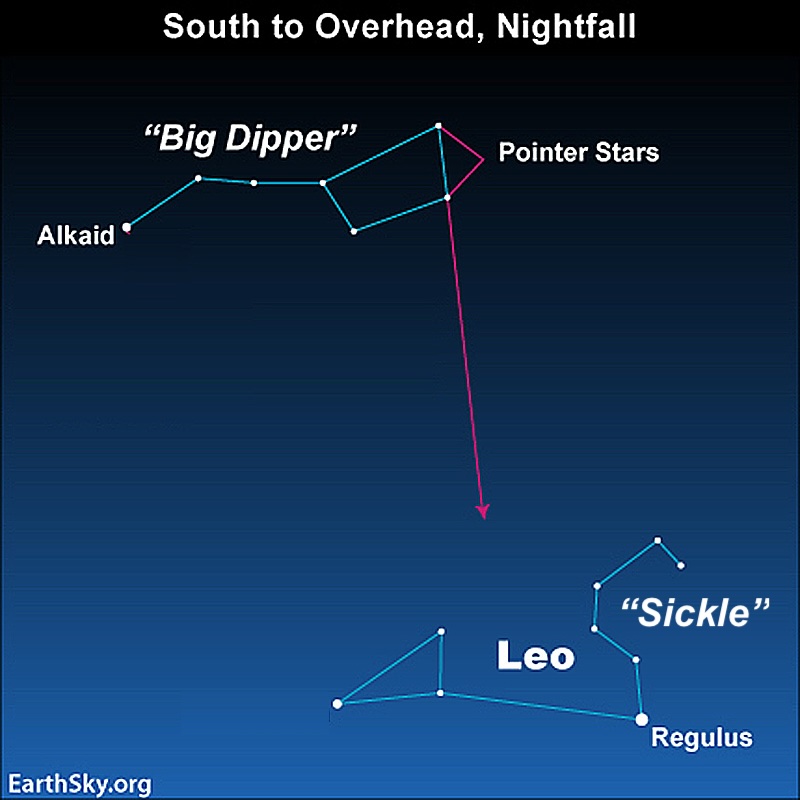 On April evenings, the Big Dipper is high and almost overhead in the sky. The Big Dipper is an asterism – a well know pattern of stars – in the constellation of Ursa Major the Great Bear. It’s handy to locate the North Star, Polaris. And you can use the Big Dipper to locate Leo the Lion. Draw an imaginary line southward from the pointer stars in the Big Dipper – the two outer stars in the Dipper’s bowl – to point toward Leo the Lion. The brightest star in Leo is Regulus.
On April evenings, the Big Dipper is high and almost overhead in the sky. The Big Dipper is an asterism – a well know pattern of stars – in the constellation of Ursa Major the Great Bear. It’s handy to locate the North Star, Polaris. And you can use the Big Dipper to locate Leo the Lion. Draw an imaginary line southward from the pointer stars in the Big Dipper – the two outer stars in the Dipper’s bowl – to point toward Leo the Lion. The brightest star in Leo is Regulus.
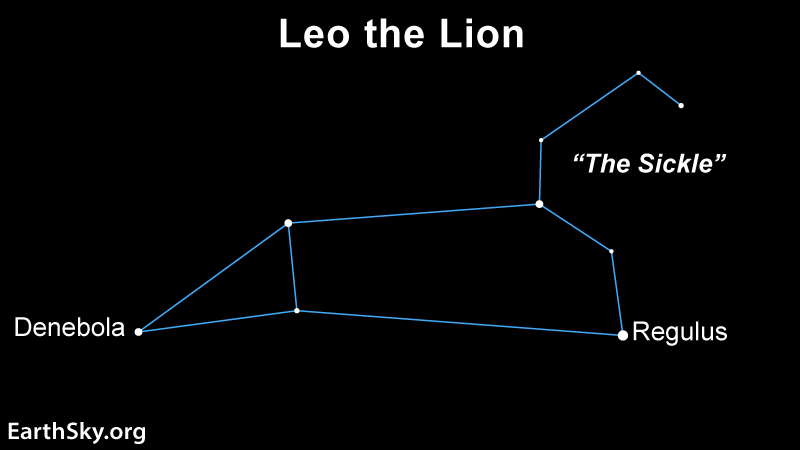 On April evenings, almost at zenith – overhead in the sky – you’ll see Leo the Lion in the sky in 2 parts. First, the stars making up a backwards question mark represents Leo’s head and it’s also known as the Sickle. And the triangle at the back represents the Lion’s hindquarters. Also, the bright star Regulus is the period at the bottom of the backward question mark. Chart via EarthSky.
On April evenings, almost at zenith – overhead in the sky – you’ll see Leo the Lion in the sky in 2 parts. First, the stars making up a backwards question mark represents Leo’s head and it’s also known as the Sickle. And the triangle at the back represents the Lion’s hindquarters. Also, the bright star Regulus is the period at the bottom of the backward question mark. Chart via EarthSky.
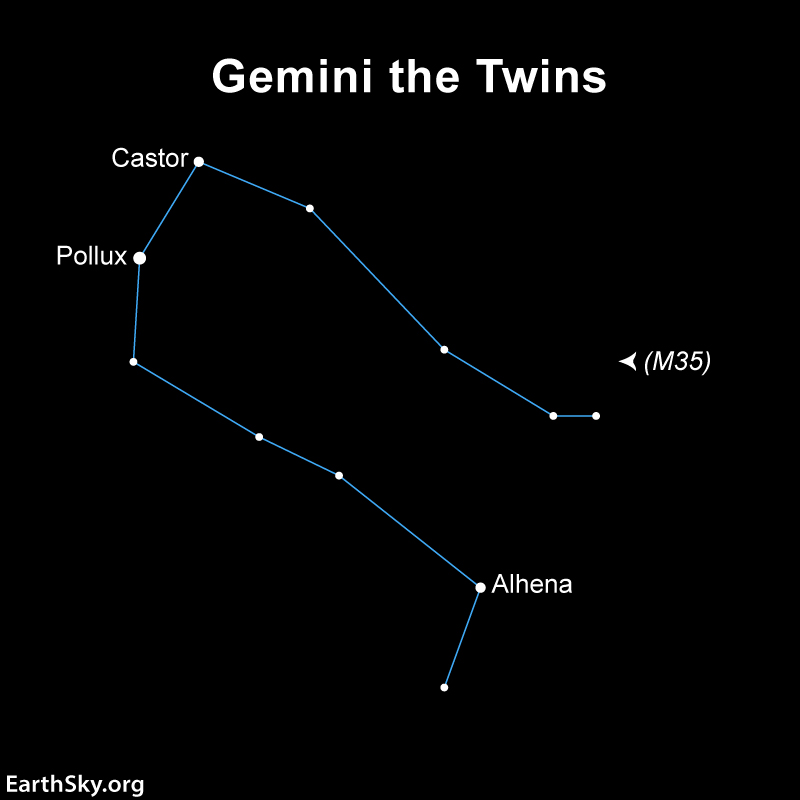 On April evenings, look overhead for the constellation Gemini the Twins. The twin stars are Castor and Pollux. However, in April 2025, there’s a trio of bright lights in Gemini. That’s because the the planet Mars is near the twin stars. Image via EarthSky.
On April evenings, look overhead for the constellation Gemini the Twins. The twin stars are Castor and Pollux. However, in April 2025, there’s a trio of bright lights in Gemini. That’s because the the planet Mars is near the twin stars. Image via EarthSky.
Our charts are mostly set for the northern half of Earth. To see a precise view – and time – from your location, try Stellarium Online.
May stars
If you’re out stargazing on any May evening, look for these stars and constellations overhead in the sky.
 On May evenings, the Big Dipper is high overhead in the sky. The Big Dipper is an asterism – a well know pattern of stars – in the constellation of Ursa Major the Great Bear. It’s handy to locate the North Star, Polaris. And you can use the Big Dipper to locate Leo the Lion. Draw an imaginary line southward from the pointer stars in the Big Dipper – the two outer stars in the Dipper’s bowl – to point toward Leo the Lion. The brightest star in Leo is Regulus.
On May evenings, the Big Dipper is high overhead in the sky. The Big Dipper is an asterism – a well know pattern of stars – in the constellation of Ursa Major the Great Bear. It’s handy to locate the North Star, Polaris. And you can use the Big Dipper to locate Leo the Lion. Draw an imaginary line southward from the pointer stars in the Big Dipper – the two outer stars in the Dipper’s bowl – to point toward Leo the Lion. The brightest star in Leo is Regulus.
 On May evenings, near your zenith – overhead in the sky – you’ll see Leo the Lion in the sky in 2 parts. First, the stars making up a backward question mark represent Leo’s head, and it’s also known as the Sickle. And the triangle at the back represents the Lion’s hindquarters. Also, the bright star Regulus is the period at the bottom of the backward question mark. Even a medium-sized telescope can zoom in on the some of the dozens of galaxies visible in that region of the sky. Chart via EarthSky.
On May evenings, near your zenith – overhead in the sky – you’ll see Leo the Lion in the sky in 2 parts. First, the stars making up a backward question mark represent Leo’s head, and it’s also known as the Sickle. And the triangle at the back represents the Lion’s hindquarters. Also, the bright star Regulus is the period at the bottom of the backward question mark. Even a medium-sized telescope can zoom in on the some of the dozens of galaxies visible in that region of the sky. Chart via EarthSky.
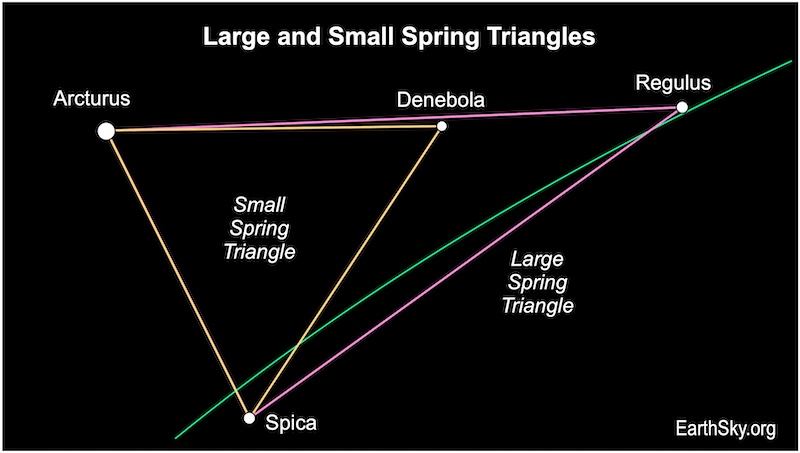 The Spring Triangle is an asterism with 3 bright stars at its corners: Arcturus, Spica and Regulus. All 3 stars are in different constellations. Regulus is in Leo the Lion. Arcturus is in Boötes the Herdsman. And Spica is in Virgo the Maiden. Some stargazers see a smaller triangle of stars, this trio of the stars is made of Arcturus, Spica and Denebola, a star in Leo. Image via EarthSky.
The Spring Triangle is an asterism with 3 bright stars at its corners: Arcturus, Spica and Regulus. All 3 stars are in different constellations. Regulus is in Leo the Lion. Arcturus is in Boötes the Herdsman. And Spica is in Virgo the Maiden. Some stargazers see a smaller triangle of stars, this trio of the stars is made of Arcturus, Spica and Denebola, a star in Leo. Image via EarthSky.
Our charts are mostly set for the northern half of Earth. To see a precise view – and time – from your location, try Stellarium Online.
April evening planets
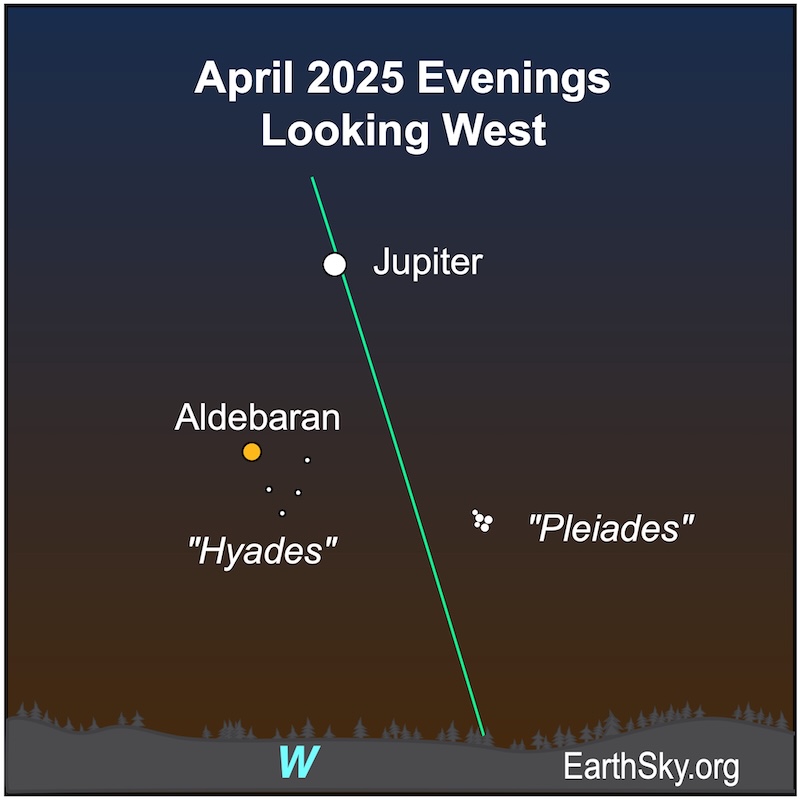 In April 2025, Jupiter will lie in the west all month after sunset. Nearby is the bright orange star, Aldebaran, the fiery eye of Taurus the Bull. Also nearby is the delicate Pleiades star cluster and the looser Hyades star cluster. Jupiter’s evening appearance is coming to an end soon, it’ll be setting about 3 hours after the sun by month’s end. Chart via EarthSky.
In April 2025, Jupiter will lie in the west all month after sunset. Nearby is the bright orange star, Aldebaran, the fiery eye of Taurus the Bull. Also nearby is the delicate Pleiades star cluster and the looser Hyades star cluster. Jupiter’s evening appearance is coming to an end soon, it’ll be setting about 3 hours after the sun by month’s end. Chart via EarthSky.
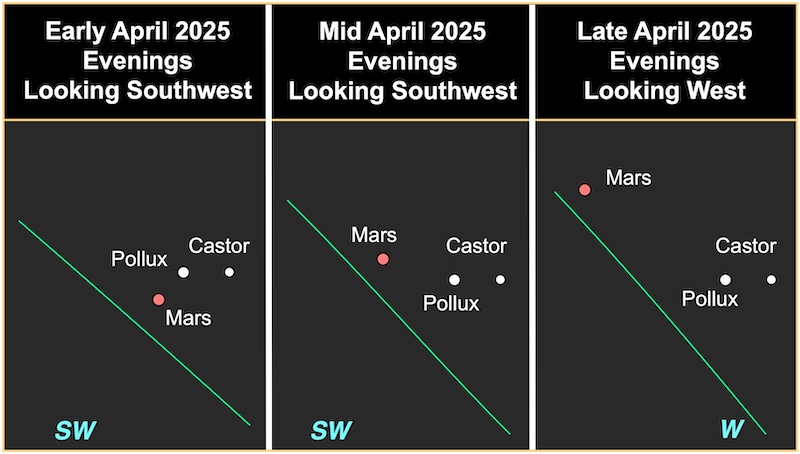 In April 2025, the red planet Mars will lie near the twin stars of Gemini: Castor and Pollux. Mars will move into Cancer the Crab this month and close to the Beehive star cluster. Mars will remain visible in the evening sky through November but continue to fade the rest of the year as it recedes from Earth. However, this month Mars will continue to shine a bit brighter than the twin stars. Chart via EarthSky.
In April 2025, the red planet Mars will lie near the twin stars of Gemini: Castor and Pollux. Mars will move into Cancer the Crab this month and close to the Beehive star cluster. Mars will remain visible in the evening sky through November but continue to fade the rest of the year as it recedes from Earth. However, this month Mars will continue to shine a bit brighter than the twin stars. Chart via EarthSky.
April morning planets
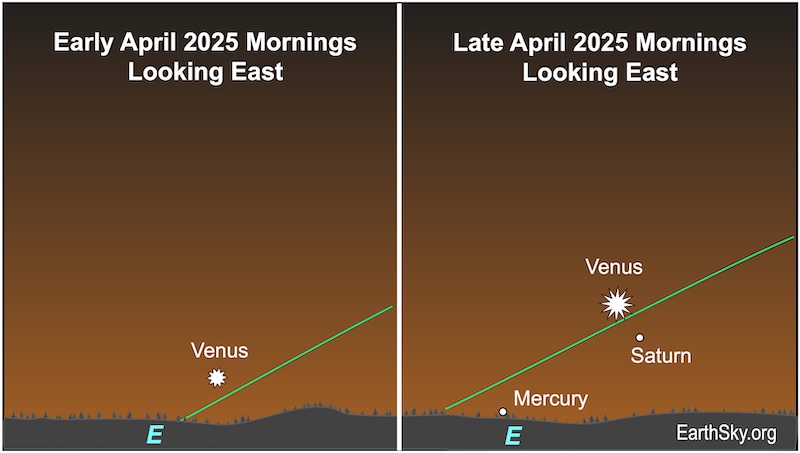 In the first half of April 2025, Venus will rise in the east about an hour before the sun. By month’s end, it’ll rise a few hours before sunrise. Venus will reach its greatest brilliancy in the morning sky on April 21, 2025. In the second half of April, Venus will grow brighter and will be joined by the much dimmer Mercury and Saturn. Mercury and Saturn will be challenging to spot in the morning twilight. Venus will reach its greatest distance from the sun on May 31-June 1, 2025. Mercury will reach its greatest elongation from the sun at 19 UTC on April 21. However, this will be the best morning apparition of Mercury for the Southern Hemisphere, and challenging to spot from the Northern Hemisphere. Saturn is just emerging from its superior conjunction, and it’ll lie close to Venus on April 23. Saturn is now showing the southern face of its rings, but the planet will be challenging to spot in the morning twilight. Venus and Saturn will be closest to each other on the morning of April 29 when they are 4 degrees apart. That’s 8 full moons lined up side-by-side. Chart via EarthSky.
In the first half of April 2025, Venus will rise in the east about an hour before the sun. By month’s end, it’ll rise a few hours before sunrise. Venus will reach its greatest brilliancy in the morning sky on April 21, 2025. In the second half of April, Venus will grow brighter and will be joined by the much dimmer Mercury and Saturn. Mercury and Saturn will be challenging to spot in the morning twilight. Venus will reach its greatest distance from the sun on May 31-June 1, 2025. Mercury will reach its greatest elongation from the sun at 19 UTC on April 21. However, this will be the best morning apparition of Mercury for the Southern Hemisphere, and challenging to spot from the Northern Hemisphere. Saturn is just emerging from its superior conjunction, and it’ll lie close to Venus on April 23. Saturn is now showing the southern face of its rings, but the planet will be challenging to spot in the morning twilight. Venus and Saturn will be closest to each other on the morning of April 29 when they are 4 degrees apart. That’s 8 full moons lined up side-by-side. Chart via EarthSky.
Our charts are mostly set for the northern half of Earth. To see a precise view – and time – from your location, try Stellarium Online.
May evening planets
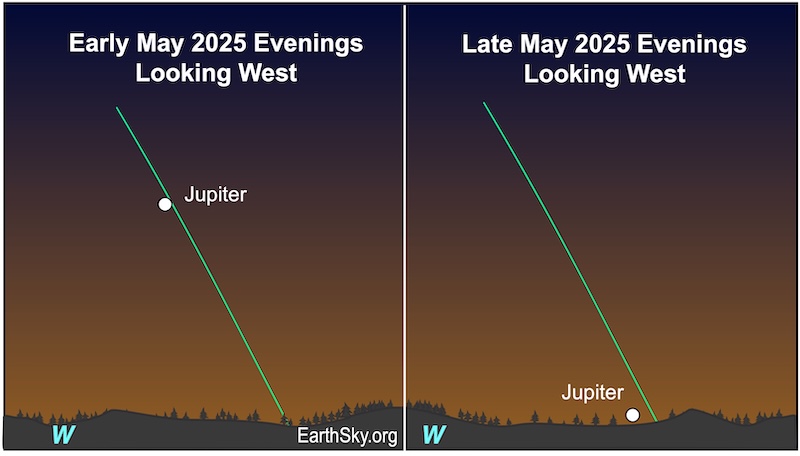 Jupiter will lie in the west after sunset all month, and it will drop a little lower toward the western horizon each night. By the end of May, Jupiter will appear very low on the horizon as darkness falls. Chart via EarthSky.
Jupiter will lie in the west after sunset all month, and it will drop a little lower toward the western horizon each night. By the end of May, Jupiter will appear very low on the horizon as darkness falls. Chart via EarthSky.
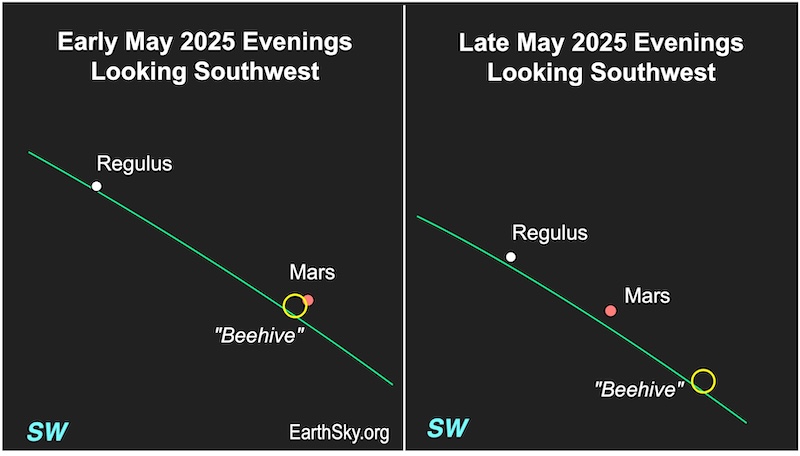 In early May, Mars will lie in the southwest as darkness falls. It will be near the Beehive star cluster (M44) in Cancer the Crab. As the month progress, Mars moves away from the Beehive and toward Regulus, the brightest star in Leo the Lion. Chart via EarthSky.
In early May, Mars will lie in the southwest as darkness falls. It will be near the Beehive star cluster (M44) in Cancer the Crab. As the month progress, Mars moves away from the Beehive and toward Regulus, the brightest star in Leo the Lion. Chart via EarthSky.
Our charts are mostly set for the northern half of Earth. To see a precise view – and time – from your location, try Stellarium Online.
May morning planets
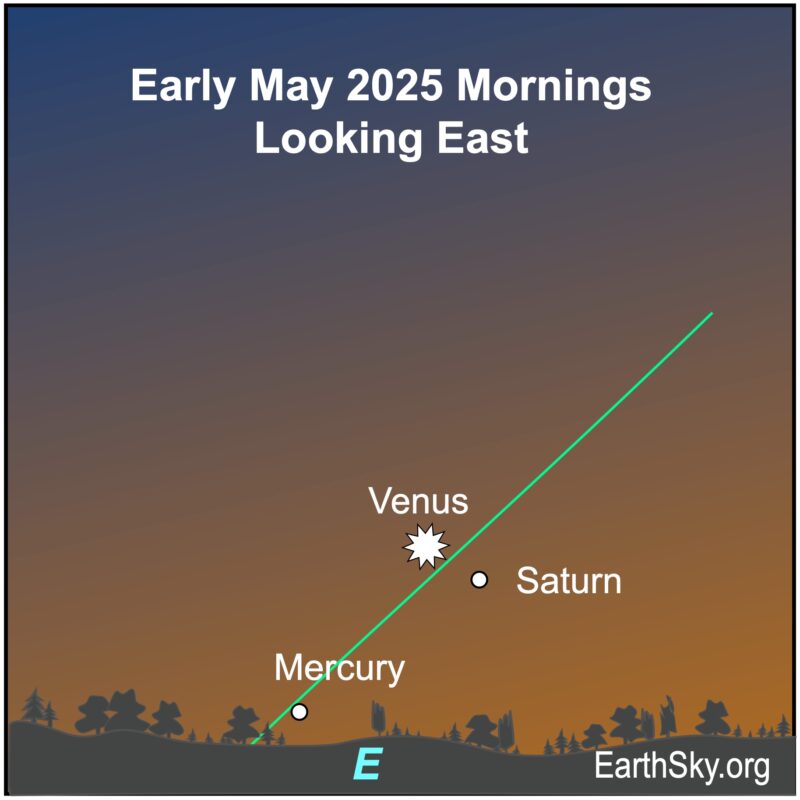 For Northern Hemisphere viewers, during the first half of May, Venus will help guide you to Mercury low in the bright morning twilight. Saturn will be near the much brighter Venus. Chart via EarthSky.
For Northern Hemisphere viewers, during the first half of May, Venus will help guide you to Mercury low in the bright morning twilight. Saturn will be near the much brighter Venus. Chart via EarthSky.
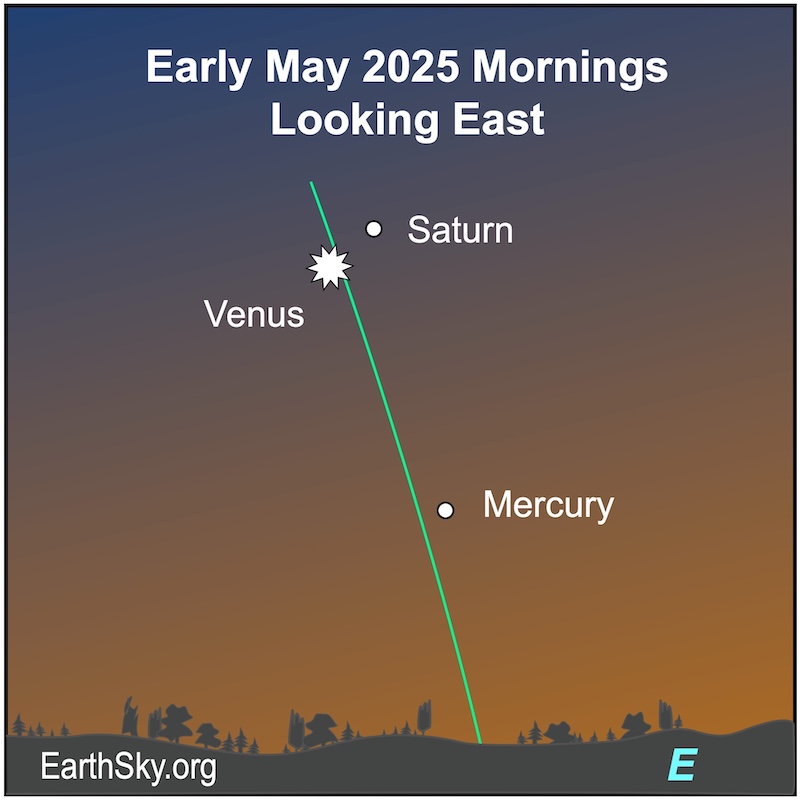 For Southern Hemisphere viewers, look for bright Venus in the morning sky. Mercury will shine in the bright morning twilight about 30 minutes before sunrise. And Saturn will be near the much brighter Venus. Chart via EarthSky.
For Southern Hemisphere viewers, look for bright Venus in the morning sky. Mercury will shine in the bright morning twilight about 30 minutes before sunrise. And Saturn will be near the much brighter Venus. Chart via EarthSky.
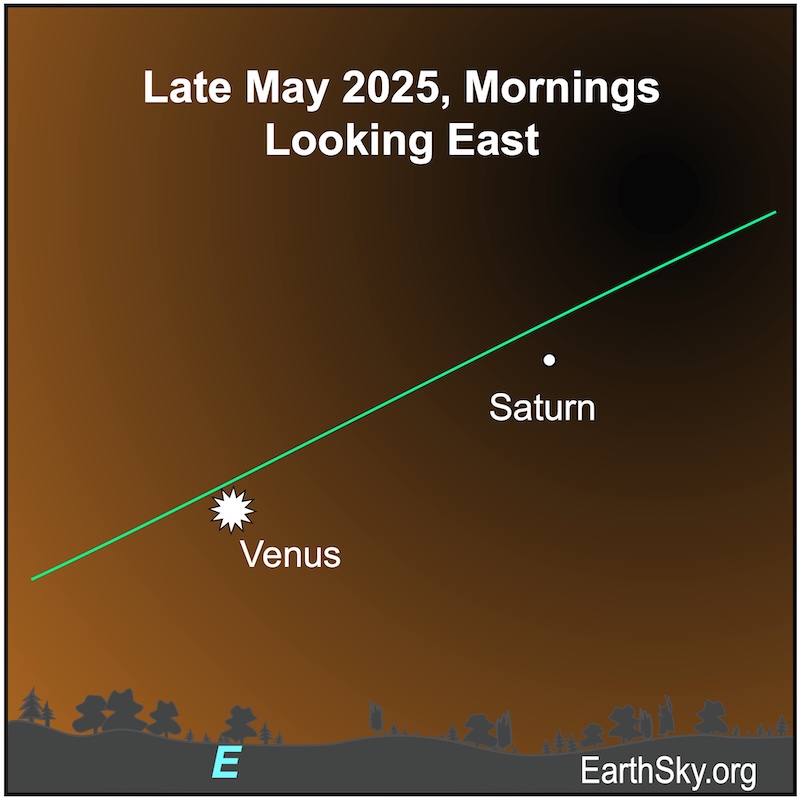 In late May, Venus will shine brilliantly in the east about 60 minutes before sunrise. And you’ll notice Venus and Saturn have moved apart. Chart via EarthSky.
In late May, Venus will shine brilliantly in the east about 60 minutes before sunrise. And you’ll notice Venus and Saturn have moved apart. Chart via EarthSky.
Sky dome map for visible planets and night sky
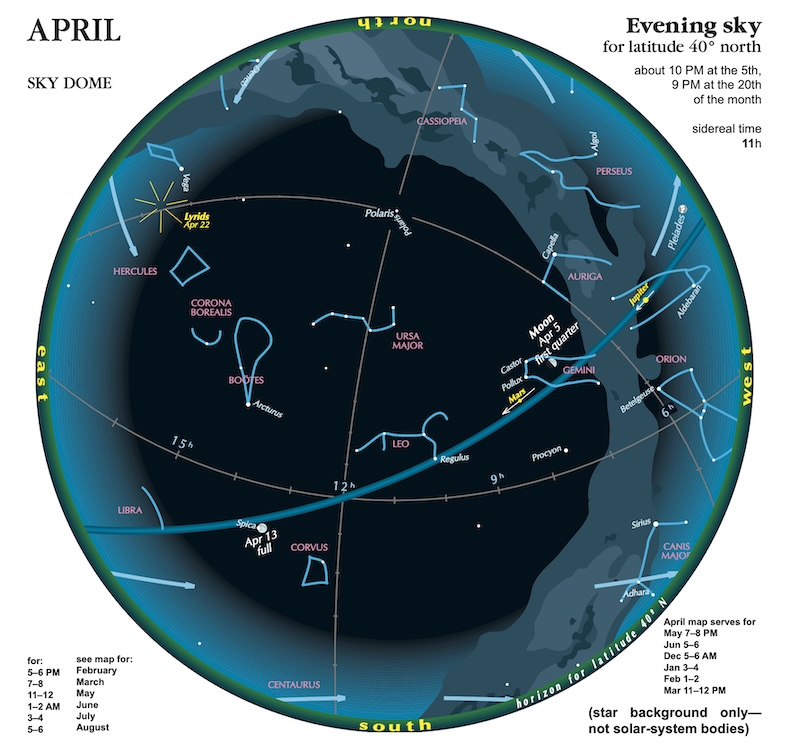 Here is the sky dome view for April 2025. It shows what is above the horizon at mid-evening for mid-northern latitudes. The view may vary depending on your location. Image via Guy Ottewell’s 2025 Astronomical Calendar.
Here is the sky dome view for April 2025. It shows what is above the horizon at mid-evening for mid-northern latitudes. The view may vary depending on your location. Image via Guy Ottewell’s 2025 Astronomical Calendar.
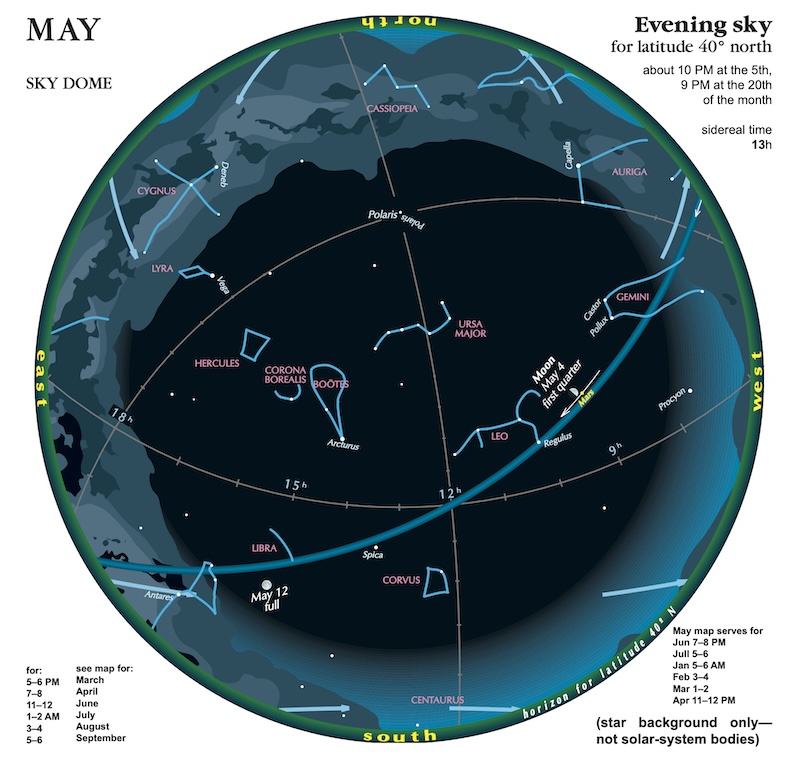 Here is the sky dome view for May 2025. It shows what is above the horizon at mid-evening for mid-northern latitudes. The view may vary depending on your location. Image via Guy Ottewell’s 2025 Astronomical Calendar.
Here is the sky dome view for May 2025. It shows what is above the horizon at mid-evening for mid-northern latitudes. The view may vary depending on your location. Image via Guy Ottewell’s 2025 Astronomical Calendar.
Read more: Guy Ottewell explains sky dome maps.
Heliocentric solar system visible planets and more
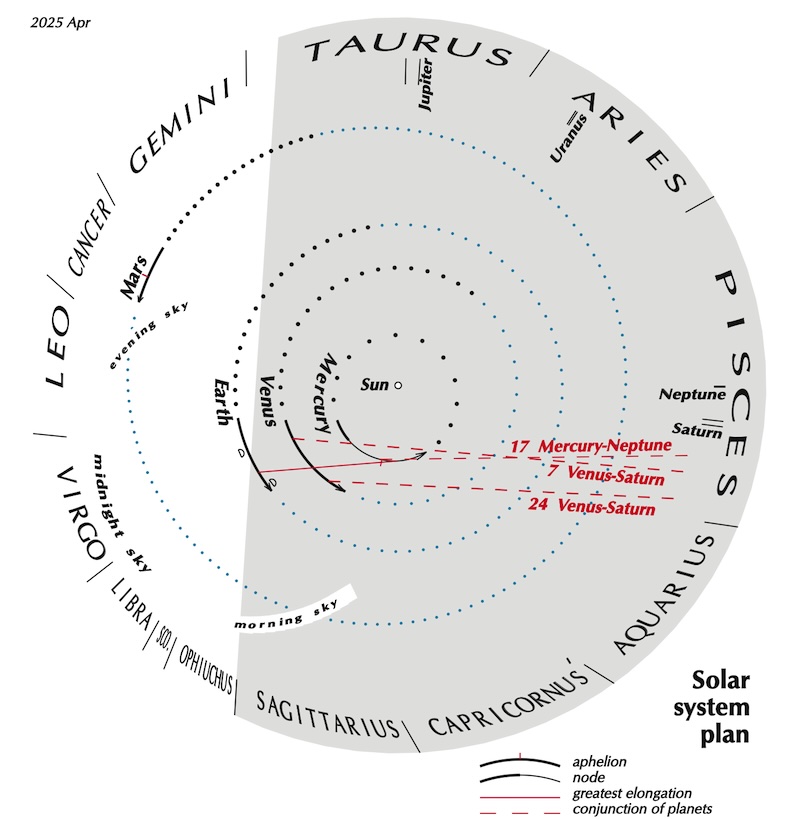 Heliocentric view of solar system, April 2025. Chart via Guy Ottewell’s 2025 Astronomical Calendar. Used with permission.
Heliocentric view of solar system, April 2025. Chart via Guy Ottewell’s 2025 Astronomical Calendar. Used with permission.
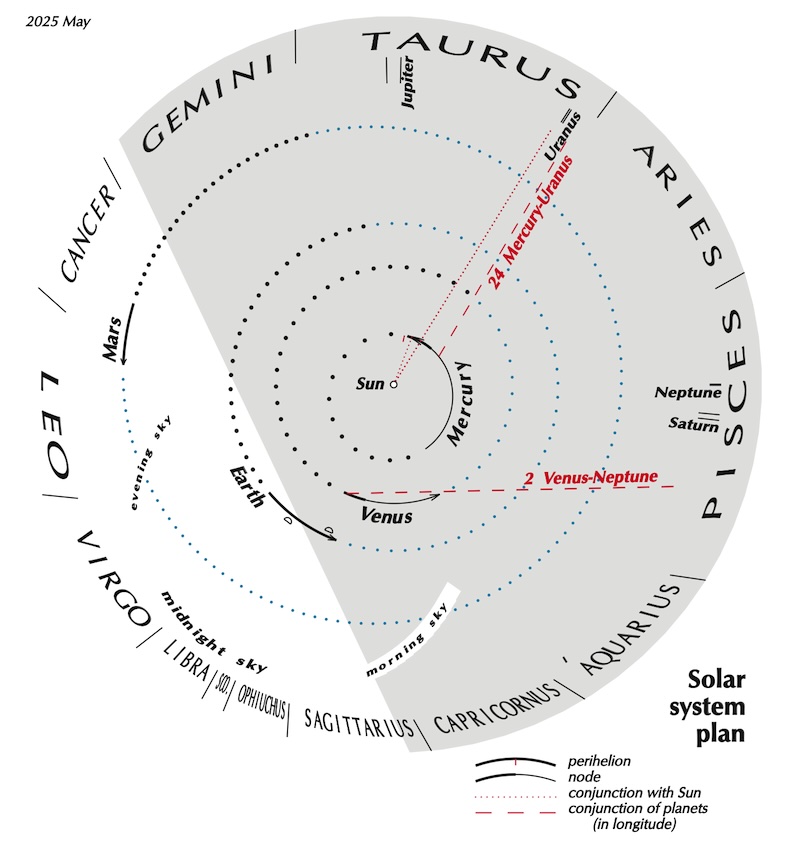 Heliocentric view of solar system, May 2025. Chart via Guy Ottewell’s 2025 Astronomical Calendar. Used with permission.
Heliocentric view of solar system, May 2025. Chart via Guy Ottewell’s 2025 Astronomical Calendar. Used with permission.
Read more: Guy Ottewell explains heliocentric charts.
Some resources to enjoy
For more videos of great night sky events, visit EarthSky’s YouTube page.
Don’t miss anything. Subscribe to daily emails from EarthSky. It’s free!
Visit EarthSky’s Best Places to Stargaze to find a dark-sky location near you.
Post your own night sky photos at EarthSky Community Photos.
See the indispensable Observer’s Handbook, from the Royal Astronomical Society of Canada.
Visit Stellarium-Web.org for precise views from your location.
Almanac: Bright visible planets (rise and set times for your location).
Visit TheSkyLive for precise views from your location.
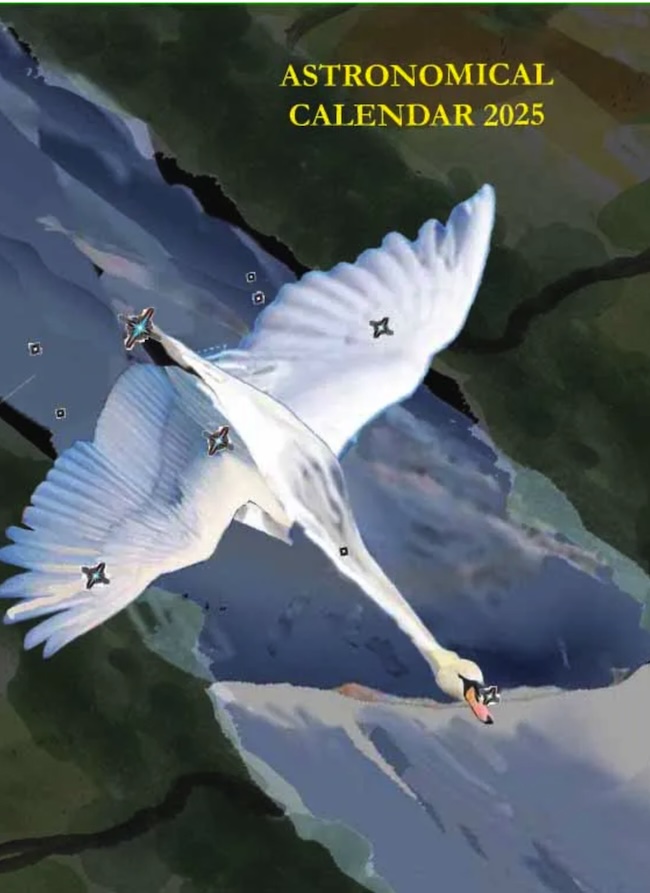 Attention amateur astronomers! Guy Ottewell’s popular and informative Astronomical Calendar for 2025 is available in both electronic and printed versions.
Attention amateur astronomers! Guy Ottewell’s popular and informative Astronomical Calendar for 2025 is available in both electronic and printed versions.
Bottom line: Visible planets and night sky guide. Watch for Venus’ greatest brilliancy tomorrow morning, and see “moon smiley face” photos from the EarthSky community.
Marcy Curran
View Articles
About the Author:
Meet Marcy Curran, our voice of the night sky on EarthSky YouTube. Check out her popular short videos in the Sky category on our YouTube channel. When she’s not making videos, Marcy is an EarthSky editor, helping to keep our night sky guide up-to-date and just generally helping to keep the wheels turning around here. Marcy has enjoyed stargazing since she was a child, going on family camping trips under the dark skies of Wyoming. She bought her first telescope in time to see Halley’s Comet when it visited the inner solar system in 1986. She co-founded her local astronomy club and remains an active board member. Marcy taught astronomy at her local community college for over 20 years. She and her husband live in Wyoming, in a rural location, with an all-sky camera and super-good horizon views! And, their observatory will soon be ready to photograph the night sky.
John Jardine Goss
View Articles
About the Author:
“I can sometimes see the moon in the daytime” was a cosmic revelation that John Jardine Goss first discovered through personal observations at age 6. It shook his young concept of the universe and launched his interest in astronomy and stargazing, a fascination he still holds today. John is past president of the Astronomical League, the largest U.S. federation of astronomical societies, with over 24,000 members. He’s earned the title of Master Observer and is a regular contributor to the video series, “Global Star Party.” He has authored the celestial observing guides “Exploring the Starry Realm,” and “Carpe Lunam,” and “Take Your First Steps, an Introduction to Amateur Astronomy.” John also wrote for twenty years the monthly stargazing column, Roanoke Skies, for the Roanoke Times, and currently writes a bimonthly column, Skywatch, for Blue Ridge Country magazine. He has contributed to Sky and Telescope magazine, the IDA Nightscape, the Astronomical League’s Reflector magazine, and the RASC Observer’s Handbook.
Deborah Byrd
View Articles
About the Author:
Our Editor-in-Chief Deborah Byrd works to keep all the astronomy balls in the air between EarthSky’s website, YouTube page and social media platforms. She’s the primary editor of our popular daily newsletter and a frequent host of EarthSky livestreams. Deborah created the EarthSky radio series in 1991 and founded EarthSky.org in 1994. Prior to that, she had worked for the University of Texas McDonald Observatory since 1976, and created and produced their Star Date radio series. She has won a galaxy of awards from the broadcasting and science communities, including having an asteroid named 3505 Byrd in her honor. In 2020, she won the Education Prize from the American Astronomical Society, the largest organization of professional astronomers in North America. A science communicator and educator since 1976, Byrd believes in science as a force for good in the world and a vital tool for the 21st century. “Being an EarthSky editor is like hosting a big global party for cool nature-lovers,” she says.
Kelly Kizer Whitt
View Articles
About the Author:
Kelly Kizer Whitt – EarthSky’s nature and travel vlogger on YouTube – writes and edits some of the most fascinating stories at EarthSky.org. She’s been writing about science, with a focus on astronomy, for decades. She began her career at Astronomy Magazine and made regular contributions to other outlets, including AstronomyToday and the Sierra Club. She has nine published books, including a children’s picture book, Solar System Forecast, and a young adult dystopian novel, A Different Sky.